2017-11-23 - Nº 134

Editorial
Esta é a Newsletter Nº 134 que se apresenta com o mesmo formato que as anteriores. Se gostar da Newsletter partilhe-a!
Todas as Newsletters encontram-se indexadas no link.
Esta Newsletter tem os seguintes tópicos:
Faz hoje anos que nascia, em 1837, Johannes Diderik van der Waals. Este físico holandês ficou conhecido pela sua pesquisa sobre os estados gasosos e líquidos da matéria. O seu principal trabalho foi desenvolver uma equação (a equação van der Waals) que - ao contrário das leis de Charles Boyle e Jacques Charles - aplica-se a gases reais. Uma vez que as moléculas têm forças de atracção e volume (por mais pequeno que seja), van der Waals introduziu na teoria duas constantes adicionais para levar em consideração essas propriedades. As fracas forças electrostáticas atractivas entre moléculas e entre átomos são chamadas de forças van der Waals em sua homenagem. Seus valiosos resultados permitiram que James Dewar e Heike Kamerlingh-Onnes estudassem os métodos de liquidificar os gases permanentes. Foi-lhe atribuído o prémio Nobel da Física em 1910.
Faz também anos hoje que nascia, em 1869, Valdemar Poulsen. Este engenheiro dinamarquês desenvolveu em 1903 o primeiro dispositivo para gerar ondas de rádio contínuas, contribuindo para o desenvolvimento da radiodifusão. O seu transmissor de arco aumentou a faixa de frequência de Duddell's Songing Arc (1900) da faixa de áudio para ondas de rádio, permitindo que a fala fosse transmitida até um raio de 240 km. Em 1920, o transmissor do arco de Poulsen era tão poderoso quanto 1000kW com faixas de até 4.000 km. Uma invenção anterior era o Telegrafono, para o qual ele submeteu uma patente na Dinamarca em 1 de Dezembro de 1898. Este foi o primeiro dispositivo na história a usar gravação de som magnético, embora esta invenção permaneça comercialmente impraticável devido à baixa saída de som até ao advento dos amplificadores de tubo de vácuo na década de 1930.
Faz igualmente hoje anos que nascia, em 1874, Theodore Lyman. Este físico norte-americano, fez estudos importantes em fenómenos relacionados com redes de difracção, nos comprimentos de onda da luz ultravioleta de vácuo descoberta por Victor Schumann e também nas propriedades da luz de um comprimento de onda extremamente curto, sobre o qual ele contribuiu com documentos valiosos para a literatura de física nos procedimentos das sociedades científicas.
Faz também anos hoje que nascia, em 1887, Henry Moseley. Este físico britânico demonstrou experimentalmente que as principais propriedades de um elemento são determinadas pelo número atómico, não pelo peso atómico, e estabeleceu firmemente a relação entre o número atómico e a carga do núcleo atómico. Usando técnicas fotográficas de raio X, ele determinou uma relação matemática entre o comprimento de onda da radiação e os números atómicos dos elementos emissores. Moseley obteve várias relações quantitativas a partir das quais ele previu a existência de três elementos em falta (números 43, 61 e 75) na tabela periódica, todos os quais foram posteriormente identificados.
Por fim, faz anos hoje que nascia, em 1894, Donald Deskey. Este desenhador industrial norte-americano ajudou a estabelecer o design industrial como uma profissão. Ele criou o uso inventivo de materiais industriais para fins decorativos. Deskey inventou um laminado de alta pressão conhecido como Weldtex. Ele projectou as luzes de rua bem conhecidas na comissão para a cidade de Nova York em 1958 como um novo protótipo de padrão de luz de rua. Ele trouxe um olhar novo e modernista para móveis e interiores, incluindo o de Radio City Music Hall.
Esta semana ficámos a saber que a Tesla vai comercializar um camião eléctrico com autonomia de 800 Km. A bateria pode ter até 1 megawatt-hora de energia. E com um sistema de Tesla Megacharger mais novo, super-rápido, um camionista pode adicionar 600 Km de alcance em 30 minutos. O Tesla Semi entrará em produção em 2019, afirma a Tesla.
Também esta semana ficámos a saber que astrónomos observaram um asteróide intrigante que se deslocou através do sistema solar numa trajectória inclinada do espaço interestelar - o primeiro objecto confirmado vindo de outro sistema estelar. Agora, novos dados revelam que o intruso interestelar é um objecto rochoso em forma de charuto com uma tonalidade um pouco avermelhada. O asteróide, chamado 'Oumuamua pelos seus descobridores, tem até 400 metros de comprimento e altamente alongado. Tem uma relação de aspecto maior que a de qualquer asteróide ou cometa observado no nosso sistema solar até à data. Embora sua forma alongada seja bastante surpreendente e, ao contrário dos asteróides observados em nosso sistema solar, pode fornecer novas pistas sobre a forma como os outros sistemas solares se formaram.
Ainda esta semana, um robô chinês tornou-se a primeira máquina do mundo a passar pelo exame médico. O robô médico chinês de IA chamado "Xiaoyi" tornou-se o primeiro no mundo a ser aprovado na prova escrita do Exame Nacional de Licenciamento Médico da China, que agora trabalhará para melhorar o diagnóstico clínico. O robô obteve 456 pontos no exame, muito acima da média nacional, de acordo com sua equipa de pesquisa no Tsinghua-iFlyTek Joint Lab da Universidade de Tsinghua e a empresa líder na China iFlyTek Co., Ltd. Xiaoyi estudou quase um milhão de imagens médicas, 53 livros médicos, dois milhões de registos médicos e 400 mil literaturas médicas e relatórios médicos antes de tentar fazer o teste, disse Wu Ji, director do laboratório conjunto.
Na Newsletter desta semana apresentamos diversos projetos de maker assim como um modelo 3D que poderá ser útil. São apresentadas as revistas newelectronics de 14 Novembro 2017, a revista HackSpace magazine #1 e a revista "AIY Voice Essentials".
 João Alves ([email protected])
João Alves ([email protected])
O conteúdo da Newsletter encontra-se sob a licença  Creative Commons Attribution-NonCommercial-ShareAlike 4.0 International License.
Creative Commons Attribution-NonCommercial-ShareAlike 4.0 International License.
Novidades da Semana

Tesla Semi: 500-Mile Range, Cheaper Than Diesel, Quick to Charge
"The Tesla Semi launched Thursday night to a host of superlatives. It’s faster, safer, and cheaper to run than anyone expected. Most of all, it will run 500 miles on a single charge, according to Tesla. The battery might have as much as 1 megawatt-hour of energy, we believe. And with a newer, super-faster Tesla Megacharger system, a trucker can add 400 miles of range in 30 minutes. The Tesla Semi will go into production in 2019, Tesla claims." [...]

Solar System's First Interstellar Visitor Dazzles Scientists
"Astronomers recently scrambled to observe an intriguing asteroid that zipped through the solar system on a steep trajectory from interstellar space-the first confirmed object from another star. Now, new data reveal the interstellar interloper to be a rocky, cigar-shaped object with a somewhat reddish hue. The asteroid, named 'Oumuamua by its discoverers, is up to one-quarter mile (400 meters) long and highly-elongated-perhaps 10 times as long as it is wide. That aspect ratio is greater than that of any asteroid or comet observed in our solar system to date. While its elongated shape is quite surprising, and unlike asteroids seen in our solar system, it may provide new clues into how other solar systems formed. The observations and analyses were funded in part by NASA and appear in the Nov. 20 issue of the journal Nature." [...]
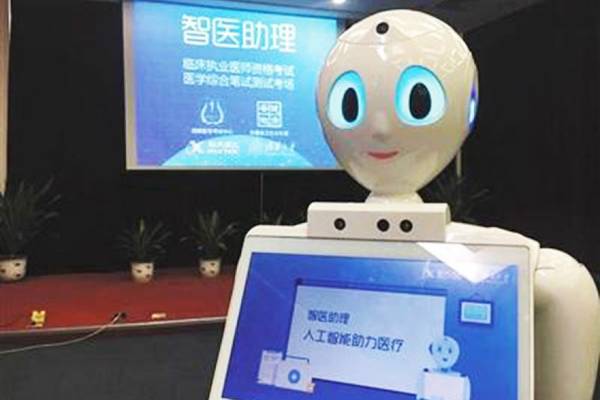
Chinese robot becomes world’s first machine to pass medical exam
"A Chinese AI medical robot named “Xiaoyi” became the world’s first to pass the written test of China’s National Medical Licensing Examination, who will now work to improve clinical diagnosis, Beijing News reported. The robot scored 456 points in the exam, well above the national average, according to its research team at the Tsinghua-iFlyTek Joint Lab of Tsinghua University and China’s leading AI enterprise iFlyTek Co., Ltd. Xiaoyi studied nearly one million medical images, 53 medical books, two million medical records, and 400,000 medical literatures and medical reports before sitting for the test, said Wu Ji, director of the joint lab. For the critics who say that the robot only works by relying on its formidable memory ability, Wu explained that it does not make sense, because medical examination questions vary every year. Wu said its study, reasoning, and judgment abilities also played a part in Xiaoyi’s success. However, the robot is not likely to replace human doctors, noted Tao Xiaodong, a project manager at iFlyTek, adding that the robot is not able to flexibly use the knowledge it possesses, as there are often unforeseen circumstances during actual diagnosis and treatment. The robot will be applied nationwide from March next year in medical education and training, and will be used to assist doctors in clinical diagnosis and treatment to improve diagnosis accuracy and shorten treatment time." [...]
Outras Notícias

Scalable clusters make HPC R&D easy as Raspberry Pi
"System with thousands of nodes brings affordable testbed to supercomputing system-software developers LOS ALAMOS, N.M., Nov. 13, 2017—A quest to help the systems software community work on very large supercomputers without having to actually test on them has spawned an affordable, scalable system using thousands of inexpensive Raspberry Pi nodes. It brings a powerful high-performance-computing testbed to system-software developers, researchers, and others who lack machine time on the world’s fastest supercomputers. “It’s not like you can keep a petascale machine around for R&D work in scalable systems software,” said Gary Grider, leader of the High Performance Computing Division at Los Alamos National Laboratory, home of the Trinity supercomputer. “The Raspberry Pi modules let developers figure out how to write this software and get it to work reliably without having a dedicated testbed of the same size, which would cost a quarter billion dollars and use 25 megawatts of electricity.” Grider conceived the new solution to provide the systems software community with an inexpensive testbed of similar scale to the largest supercomputers being deployed. Designed and built by BitScope and distributed by SICORP, the Pi Cluster Modules enable developers to build, scale and test software before launching it on Trinity, Crossroads, and other large systems. The modules have other potential applications from education to the internet of things." [...]

Zhejiang Geely Holding Group completes acquisition of Terrafugia Inc
" Zhejiang Geely Holding Group (‘Geely Holding’) is pleased to announce it has entered into an agreement with Terrafugia Inc, a US-based company focused on the innovation, engineering and production of flying cars and future technologies, to acquire its operations and assets in their entirety. Terrafugia was founded in 2006 by five award-winning graduates of the Massachusetts Institute of Technology. Since its inception, the company has made considerable progress towards realizing its vision of bringing a new form of mobility to the world, and delivered a number of working prototypes. Terrafugia aims to deliver its first flying car to the market in 2019, with the world’s first VTOL (vertical take-off and landing) flying car being made available by 2023. Under the terms of the agreement, Terrafugia will remain domiciled and headquartered in the United States of America, and continue to focus on its existing mission of developing flying cars. Terrafugia will also benefit from the Group’s significant expertise and track record of innovation within the global auto industry." [...]

China sets out long-term space transportation roadmap including a nuclear space shuttle
"The main contractor for the Chinese space programme has set out a space transportation roadmap which could massively boost capabilities and reduce costs for access to space. The China Aerospace Science and Technology Corporation (CASC) roadmap sets out a string of ambitious targets related to space technology, space science and space applications from 2017 to 2045. By 2020 CASC will have a wide range of launch capabilities through its expendable Long March rocket families, with the low-cost Long March 8 rocket to be in action by this time, adding to the new capabilities of the Long March 5 and 7. 2025 is the marker for the successful development of a reusable space plane, initially using two stages for suborbital flight, including for tourism purposes. The debut flight for the space plane has earlier been stated as being set for 2020. Eventually the spacecraft would use combined cycle propulsion for orbital flight." [...]

Marvell and Cavium to Combine Creating an Infrastructure Solutions Powerhouse
"Marvell Technology Group Ltd. (NASDAQ: MRVL) and Cavium, Inc. (NASDAQ: CAVM) today announced a definitive agreement, unanimously approved by the boards of directors of both companies, under which Marvell will acquire all outstanding shares of Cavium common stock in exchange for consideration of $40.00 per share in cash and 2.1757 Marvell common shares for each Cavium share. Upon completion of the transaction, Marvell will become a leader in infrastructure solutions with approximately $3.4 billion1 in annual revenue. The transaction combines Marvell’s portfolio of leading HDD and SSD storage controllers, networking solutions and high-performance wireless connectivity products with Cavium’s portfolio of leading multi-core processing, networking communications, storage connectivity and security solutions. The combined product portfolios provide the scale and breadth to deliver comprehensive end-to-end solutions for customers across the cloud data center, enterprise and service provider markets, and expands Marvell’s serviceable addressable market to more than $16 billion. This transaction also creates an R&D innovation engine to accelerate product development, positioning the company to meet today’s massive and growing demand for data storage, heterogeneous computing and high-speed connectivity. “This is an exciting combination of two very complementary companies that together equal more than the sum of their parts,” said Marvell President and Chief Executive Officer, Matt Murphy." [...]
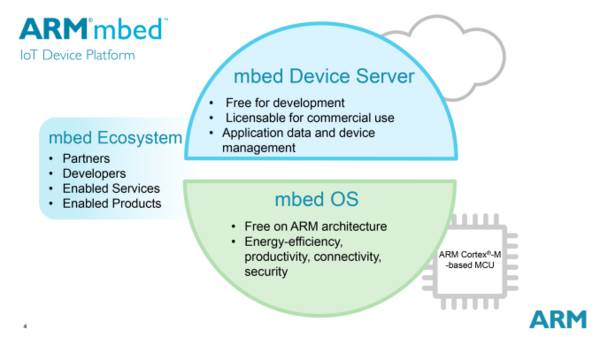
mbed OS 5.6.5 released
"We are pleased to announce the Mbed OS 5.6.5 release is now available. This is the latest patch release based on the feature set introduced by Mbed OS 5.6. Summary This patch release includes new target support for the following boards: NUCLEO_L496ZG_P L-Tek FF-LPC546XX Mbed Connect Cloud board ADI EV-COG-AD4050LZ RedBear BLE Nano 2 ADI EV-COG-AD3029LZ There was a workaround that went into mbed-os-5.6.4 for STM32 F767 rev A devices, to address an issue where the Ethernet peripheral had problems on the RMII interface. This workaround turned out to be an incomplete solution, that has now been corrected for this release. We've added bootloader support for DISCO_L475VG_IOT01A and HEXIWEAR, CAN3 support for STM32 and initial cryptographic acceleration support for the Silicon Labs family. We've made some quality improvements by extending the test set for Ticker class, updating the BLE BatteryService documentation and fixing a number of broken test cases." [...]
Ciência e Tecnologia

Breakthrough could launch organic electronics beyond cell phone screens
"A discovery by an international team of researchers from Princeton University, the Georgia Institute of Technology and Humboldt University in Berlin points the way to more widespread use of an advanced technology generally known as organic electronics. The research, published Nov. 13 in the journal Nature Materials, focuses on organic semiconductors, a class of materials prized for their applications in emerging technologies such as flexible electronics, solar energy conversion, and high-quality color displays for smartphones and televisions. In the short term, the advance should particularly help with organic light-emitting diodes that operate at high energy to emit colors such as green and blue. “Organic semiconductors are ideal materials for the fabrication of mechanically flexible devices with energy-saving low temperature processes,” said Xin Lin, a doctoral student and a member of the Princeton research team. “One of their major disadvantages has been their relatively poor electrical conductivity, which leads to inefficient devices with a shorter operating lifetime than is required for commercial applications. We are working to improve the electrical properties of organic semiconductors to make them available for more applications.” Semiconductors, typically made of silicon, are the foundation of modern electronics because engineers can take advantage of their unique properties to control electrical currents." [...]
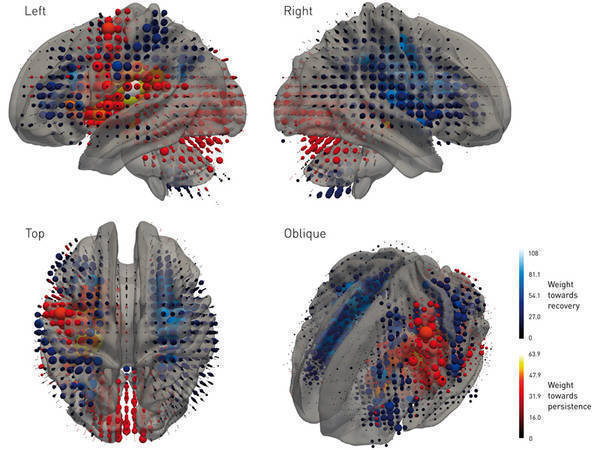
Improving clinical trials with machine learning
"Machine learning could improve our ability to determine whether a new drug works in the brain, potentially enabling researchers to detect drug effects that would be missed entirely by conventional statistical tests, finds a new UCL study published today in Brain. “Current statistical models are too simple. They fail to capture complex biological variations across people, discarding them as mere noise. We suspected this could partly explain why so many drug trials work in simple animals but fail in the complex brains of humans. If so, machine learning capable of modelling the human brain in its full complexity may uncover treatment effects that would otherwise be missed,” said the study’s lead author, Dr Parashkev Nachev (UCL Institute of Neurology). To test the concept, the research team looked at large-scale data from patients with stroke, extracting the complex anatomical pattern of brain damage caused by the stroke in each patient, creating in the process the largest collection of anatomically registered images of stroke ever assembled." [...]
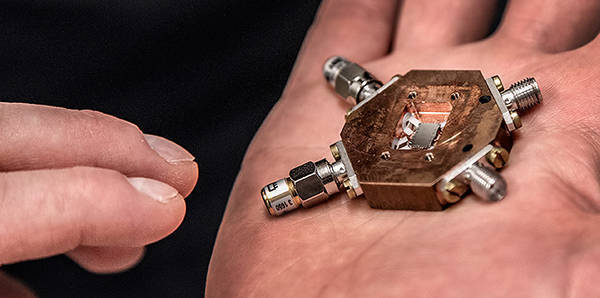
Engineering of a Swedish quantum computer set to start
"A SEK 1 billion research initiative is setting Sweden on course to a global top position in quantum technology. The focus is on developing a quantum computer with much greater computing power than the best supercomputers of today. The initiative, which is headed up by Professor Per Delsing at Chalmers University of Technology, has been made possible by an anniversary donation of SEK 600 million from the Knut and Alice Wallenberg Foundation. The progress of research in quantum technology in recent years has brought the world to the brink of a new technology revolution – the second quantum revolution. Researchers have learnt to control individual quantum systems such as individual atoms, electrons and particles of light, which is opening the door to completely new possibilities. Extremely rapid computers, intercept-proof communications and hyper-sensitive measurement methods are in sight." [...]

Three-Dimensional Nanomagnets for the computer of tomorrow
"Since the late 60´s electronic devices have stored and transmitted information (bits) in two-dimensional circuits. Now, researchers at the University of Cambridge have been able to break this barrier by creating a nanoscale magnetic circuit capable of moving information along the three dimensions of space. This breakthrough could lead to an important increase in storage and processing capacities of electronic devices over those used today. The information revolution that has shaped society into what it is today has been based on traditional printing of ever-shrinking electronic components. With current technologies reaching the limits of what Physics allows, researchers are starting to explore the third dimension in search for a route to continue improving those electronic devices in our pockets. In a recent study published in the journal ACS Nano, researchers at the university of Cambridge (UK) and TU Eindhoven (Netherlands), demonstrate how by combining the most advanced techniques in 3D-nanprinting with traditional methods it becomes possible to create functional circuits that can process information." [...]
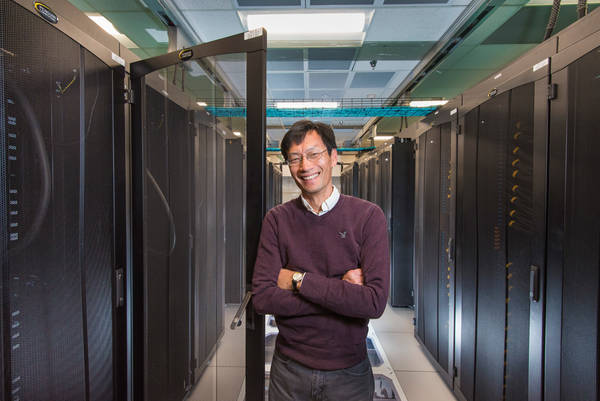
Diagnosing supercomputer problems
"A team of computer scientists and engineers from Sandia National Laboratories and Boston University recently received a prestigious award at the International Supercomputing conference for their paper on automatically diagnosing problems in supercomputers. The research, which is in the early stages, could lead to real-time diagnoses that would inform supercomputer operators of any problems and could even autonomously fix the issues, said Jim Brandt, a Sandia computer scientist and author on the paper. Supercomputers are used for everything from forecasting the weather and cancer research to ensuring U.S. nuclear weapons are safe and reliable without underground testing. As supercomputers get more complex, more interconnected parts and processes can go wrong, said Brandt. Physical parts can break, previous programs could leave “zombie processes” running that gum up the works, network traffic can cause a bottleneck or a computer code revision could cause issues. These kinds of problems can lead to programs not running to completion and ultimately wasted supercomputer time, Brandt added." [...]
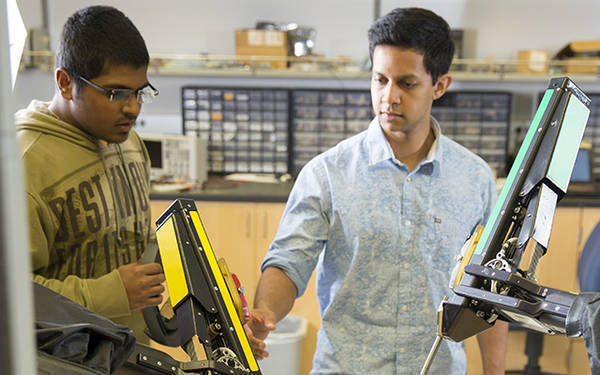
Speedy Collision Detector Could Make Robots Better Human Assistants
"Electrical engineers at the University of California San Diego have developed a faster collision detection algorithm that uses machine learning to help robots avoid moving objects and weave through complex, rapidly changing environments in real time. The algorithm, dubbed “Fastron,” runs up to 8 times faster than existing collision detection algorithms. A team of engineers, led by Michael Yip, a professor of electrical and computer engineering and member of the Contextual Robotics Institute at UC San Diego, will present the new algorithm at the first annual Conference on Robot Learning Nov. 13 to 15 at Google headquarters in Mountain View, Calif. The conference brings the top machine learning scientists to an invitation-only event. Yip’s team will deliver one of the long talks during the 3-day conference. The team envisions that Fastron will be broadly useful for robots that operate in human environments where they must be able to work with moving objects and people fluidly." [...]

Supercomputing Speeds Up Deep Learning Training
"A team of researchers from the University of California, Berkeley, the University of California, Davis and the Texas Advanced Computing Center (TACC) published the results of an effort to harness the power of supercomputers to train a deep neural network (DNN) for image recognition at rapid speed. The researchers efficiently used 1024 Skylake processors on the Stampede2 supercomputer to complete a 100-epoch ImageNet training with AlexNet in 11 minutes - the fastest time recorded to date. Using 1600 Skylake processors they also bested Facebook's prior results by finishing a 90-epoch ImageNet training with ResNet-50 in 32 minutes and, for batch sizes above 20,000, their accuracy was much higher than Facebook's. (In recent years, the ImageNet benchmark — a visual database designed for use in image recognition research — has played a significant role in assessing different approaches to DNN training.) Using 512 Intel Xeon Phi chips on Stampede2 they finished the 100-epoch AlexNet in 24 minutes and 90-epoch ResNet-50 in 60 minutes. "These results show the potential of using advanced computing resources, like those at TACC, along with large mini-batch enabling algorithms, to train deep neural networks interactively and in a distributed way," said Zhao Zhang, a research scientist at TACC, a leading supercomputing center." [...]
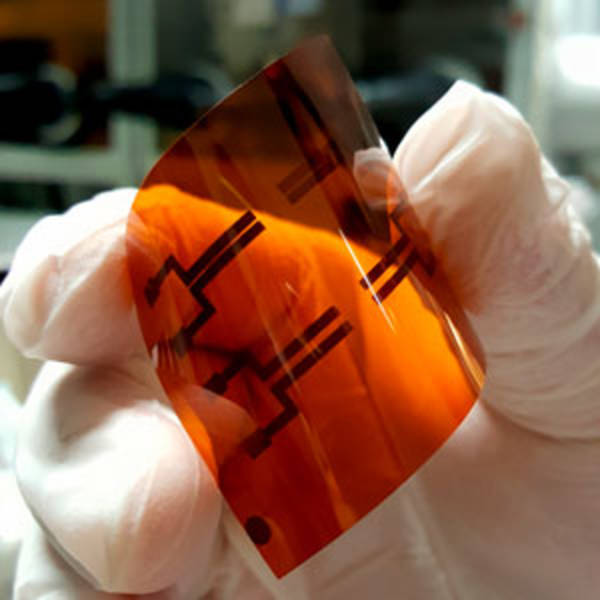
Less is more to produce top-notch 2D materials
"A simple technique for mass producing ultrathin, high-quality molybdenum trioxide nanosheets could lead to next-generation electronic and optoelectronic devices Molybdenum trioxide (MoO3) has potential as an important two-dimensional (2D) material, but its bulk manufacture has lagged behind that of others in its class. Now, researchers at A*STAR have developed a simple method for mass producing ultrathin, high-quality MoO3 nanosheets.1 Following the discovery of graphene, other 2D materials such as transition metal di-chalcogenides, began to attract considerable attention. In particular, MoO3 emerged as an important 2D semiconducting material because of its remarkable electronic and optical properties that hold promise for a range of new applications in electronics, optoelectronics and electrochromics. Liu Hongfei and colleagues from the A*STAR Institute of Materials Research and Engineering and Institute of High Performance Computing have sought to develop a simple technique for mass producing large, high-quality nanosheets of MoO3 that are flexible and transparent. “Atomically thin nanosheets of molybdenum trioxide have novel properties that can be utilized in a range of electronic applications,” says Liu. “But to produce good quality nanosheets, the parent crystal must be of very high purity.” By first using a technique called thermal vapor transport, the researchers evaporated MoO3 powder in a tube-furnace at 1,000 degrees Celsius." [...]
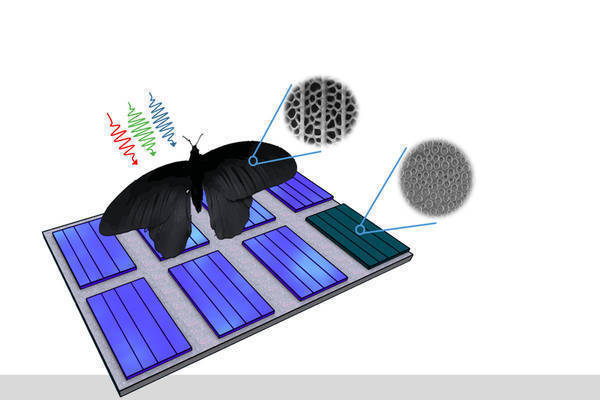
Butterfly Wing Inspires Photovoltaics: Light Absorption Can Be Enhanced by Up to 200 Percent
"Nanostructures Optimize Light Absorption in Black Butterflies – Principle Can Be Transferred to Photovoltaics for Improving Light Harvesting in Thin-Film Solar Cells – Cell Efficiency Increase Sunlight reflected by solar cells is lost as unused energy. The wings of the butterfly Pachliopta aristolochiae are drilled by nanostructures (nanoholes) that help absorbing light over a wide spectrum far better than smooth surfaces. Researchers of Karlsruhe Institute of Technology (KIT) have now succeeded in transferring these nanostructures to solar cells and, thus, enhancing their light absorption rate by up to 200 percent. The scientists report their results in the journal Science Advances. DOI: 10.1126/sciadv.1700232. “The butterfly studied by us is very dark black." [...]

Simple is Beautiful in Quantum Computing
"Defect spins in diamond were controlled with a simpler, geometric method, leading to faster computing. Quantum computing could solve problems impossible for today’s supercomputers. The challenge for this new form of computing is processing the quantum bits (qubits) that represent data. A qubit can be made by controlling the orientation of an electron’s spin at a defect site in diamond. To solve a problem, a quantum computer uses logic gates to couple multiple qubits and output new information. Scientists designed a new protocol that can be used to develop fast, robust logic gates for qubits." [...]

Zipping DNA
"ETH researchers have developed a method that allows large amounts of genetic information to be compressed and then decompressed again in cells. This could aid in the development of new therapies. What do you do if you have a large document or a high-resolution image that is too big to send via email? You simply zip it to a more manageable size using a suitable software. “Instead of sending the information ‘white-white-white-white-white-…’ for every single pixel on a white line, only the message ‘white 1,000 times’ is transmitted,” explains Kobi Benenson, Head of the Synthetic Biology Group at ETH’s Department of Biosystems Science and Engineering in Basel. Once received, the information can then be returned to its original size, i.e." [...]
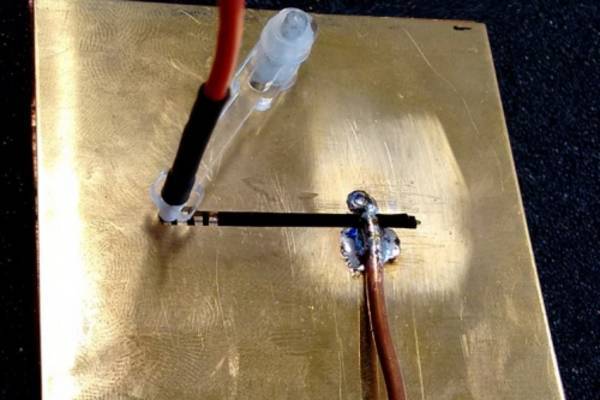
Optically tunable microwave antennas for 5G applications
"Multiband tunable antennas are a critical part of many communication and radar systems. New research by engineers at the University of Bristol has shown significant advances in antennas by using optically induced plasmas in silicon to tune both radiation patterns and operation frequency. Conventional antenna tuning is performed with diodes or Micro-Electro-Mechanical Systems (MEMS) switches. However, these approaches have significant drawbacks as systems become more complex and move to higher frequencies, which is anticipated for 5G systems. The first paper, published in IET Optoelectronics, co-authored by Dr Chris Gamlath, Research Associate in RF Engineering during his PhD, shows how a silicon superstrate placed over a slotted microstrip patch can be used to tune radiation patterns. The second paper published in IEEE Transactions on Antennas and Propagation, co-authored by Dr Michael Collett during his PhD, demonstrates how silicon can be placed within the slots of an air-spaced, cavity-backed antenna to perform frequency and pattern tuning that achieves high efficiencies." [...]
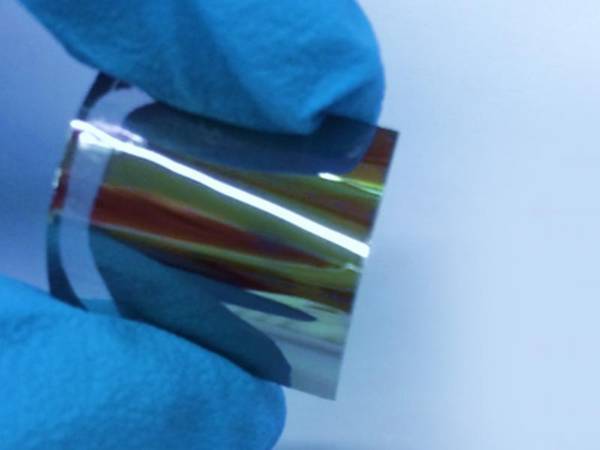
New Deposition Technique Puts the Heat on Silicon
"In the early history of electronic devices, germanium, a more efficient elemental semiconductor than silicon, was the material of choice. Ultimately, the high cost of developing germanium crystals eclipsed its efficiency, and silicon captured the field. But new research establishing an economical method for growing crystalline thin-film germanium – using a process known as van der Waals epitaxy — challenges that supremacy. “This is the first time strain-free van der Waals epitaxy of an elemental semiconductor has been demonstrated,” said Aaron Littlejohn, a doctoral candidate in the laboratory of Gwo-Ching Wang, professor of physics, applied physics, and astronomy at Rensselaer Polytechnic Institute. “Our research found a narrow window, a very specific set of conditions that work.” Interestingly, the technique produces flexible germanium that which can be removed from the substrate. “Our germanium film could be used as a thin-film nanomembrane, which could be integrated into electronic devices more easily than nanocrystals or nanowires,” said Littlejohn, who is first author on the research." [...]
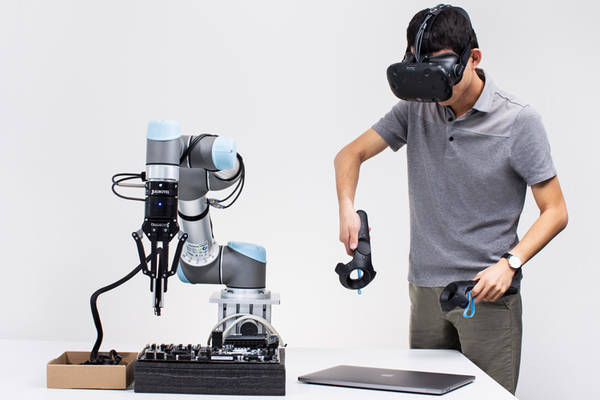
Berkeley startup to train robots like puppets
"Robots today must be programmed by writing computer code, but imagine donning a VR headset and virtually guiding a robot through a task, like you would move the arms of a puppet, and then letting the robot take it from there. That’s the vision of Pieter Abbeel, a professor of electrical engineering and computer science at the University of California, Berkeley, and his students, Peter Chen, Rocky Duan and Tianhao Zhang, who have launched a startup, Embodied Intelligence Inc., to use the latest techniques of deep reinforcement learning and artificial intelligence to make industrial robots easily teachable. “Right now, if you want to set up a robot, you program that robot to do what you want it to do, which takes a lot of time and a lot of expertise,” said Abbeel, who is currently on leave to turn his vision into reality. “With our advances in machine learning, we can write a piece of software once — machine learning code that enables the robot to learn — and then when the robot needs to be equipped with a new skill, we simply provide new data.” The “data” is training, much like you’d train a human worker, though with the added dimension of virtual reality. Using a VR headset without ever touching the robot, people can train a robot in a day, in contrast to the weeks to months typically required to write new computer code to reprogram a robot. The technique can work with robots currently in manufacturing plants and warehouses around the world." [...]
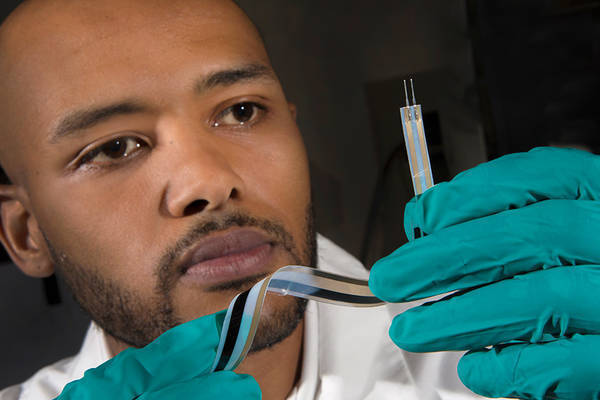
New motion sensors a major step toward low-cost, high-performance wearable technology
"Researchers from the FAMU-FSU College of Engineering have developed a class of breakthrough motion sensors that could herald a near future of ubiquitous, fully integrated and affordable wearable technology. In a paper published in the journal Materials and Design, engineers from FSU’s High-Performance Materials Institute, in collaboration with scientists from Institut National des Sciences Appliquées in Lyon, France, detail the impressive properties and cost-effective manufacturing process of an advanced series of motion sensors made using buckypaper — razor thin, flexible sheets of pure, exceptionally durable carbon nanotubes. These new buckypaper sensors represent a marked improvement on current industry standards, with most sensors being either too crude or too inflexible to reliably monitor complex structures like the human body. “Current technology is not designed for that,” said Richard Liang, director of the High-Performance Materials Institute and professor at the FAMU-FSU College of Engineering. “For sensor technology, you need it to be flexible, you need it to be affordable and you need it to be scalable. This new technology is versatile and the sensors are affordable to print." [...]
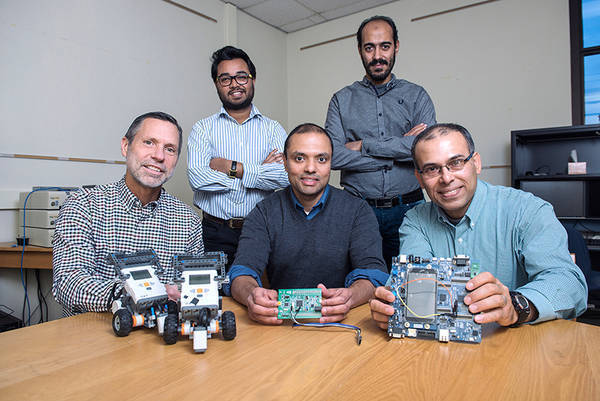
Game theory harnessed for cybersecurity of large-scale nets
"Researchers have laid the groundwork for a method to improve cybersecurity for large-scale systems like the power grid and autonomous military defense networks by harnessing game theory and creating new intelligent algorithms. Purdue University is leading the research, working with counterparts at Sandia National Laboratories. The work is funded with grants totaling about $700,000 from the National Science Foundation and Sandia. The project harnesses the Nash equilibrium, developed by Nobel laureate John Nash, whose life was chronicled in the film “A Beautiful Mind.” The work also applies “prospect theory,” which describes how people make decisions when there is uncertainty and risk, decisions that are often “only partly rational,” said Shreyas Sundaram, an assistant professor in Purdue’s School of Electrical and Computer Engineering. “The research will lead to a more complete understanding of the vulnerabilities that arise in large-scale interconnected systems and guide us to the design of more secure systems, with corresponding societal benefits,” he said. Sundaram leads the NSF-funded part of the project, working with co-principal investigators Saurabh Bagchi, a professor in the School of Electrical and Computer Engineering and Department of Computer Science, and Timothy Cason, a professor of economics in the Krannert School of Management." [...]
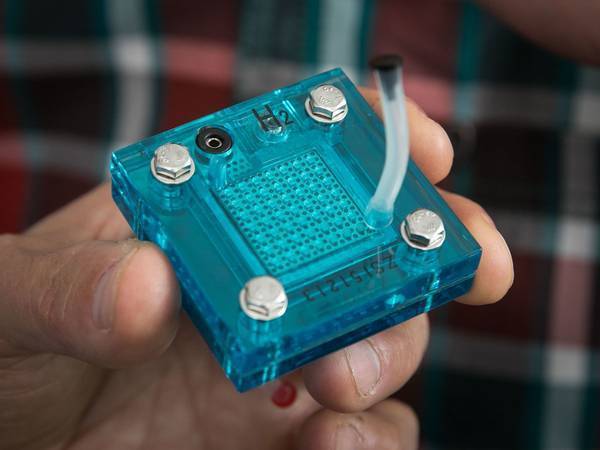
Hydrogen cars for the masses one step closer to reality, thanks to UCLA invention
"2-in-1 device also uses supercapacitor to store energy that could power computers and smartphones UCLA researchers have designed a device that can use solar energy to inexpensively and efficiently create and store energy, which could be used to power electronic devices, and to create hydrogen fuel for eco-friendly cars. The device could make hydrogen cars affordable for many more consumers because it produces hydrogen using nickel, iron and cobalt — elements that are much more abundant and less expensive than the platinum and other precious metals that are currently used to produce hydrogen fuel. “Hydrogen is a great fuel for vehicles: It is the cleanest fuel known, it’s cheap and it puts no pollutants into the air — just water,” said Richard Kaner, the study’s senior author and a UCLA distinguished professor of chemistry and biochemistry, and of materials science and engineering. “And this could dramatically lower the cost of hydrogen cars.” The technology, described in a paper in the journal Energy Storage Materials, could be especially useful in rural areas, or to military units serving in remote locations. “People need fuel to run their vehicles and electricity to run their devices,” Kaner said. “Now you can make both electricity and fuel with a single device.” It could also be part of a solution for large cities that need ways to store surplus electricity from their electrical grids." [...]
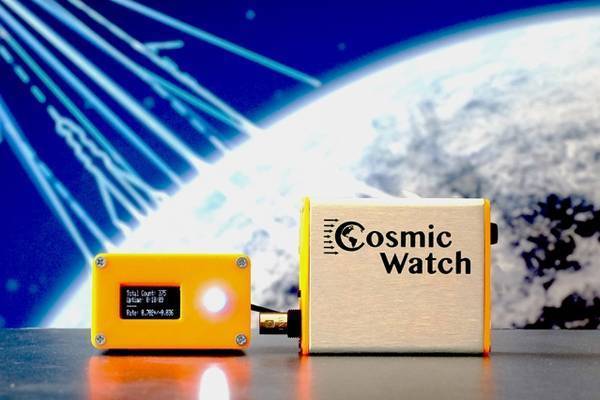
Physicists design $100 handheld muon detector
"Pocket-sized device detects charged particles in surrounding air. At any given moment, the Earth’s atmosphere is showered with high-energy cosmic rays that have been blasted from supernovae and other astrophysical phenomena far beyond the Solar System. When cosmic rays collide with the Earth’s atmosphere, they decay into muons — charged particles that are slightly heavier than an electron. Muons last only fractions of a second, and during their fleeting lifespan they can be found through every layer of the Earth’s atmosphere, circulating in the air around us and raining onto the surface at a rate similar to a light drizzle. A small fraction of muons can even penetrate the Earth’s surface and travel several kilometers through rock and ice. Now physicists working in MIT's Laboratory for Nuclear Science have designed a pocket-sized cosmic ray muon detector to track these ghostly particles." [...]
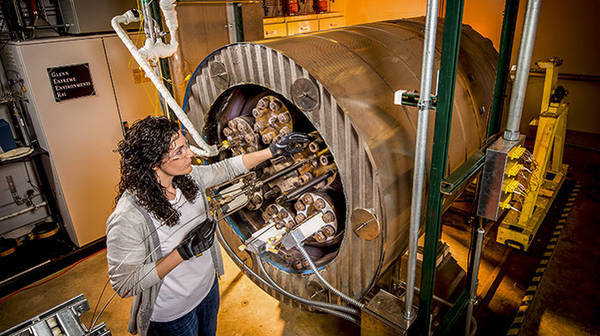
Armed with tough computer chips, scientists are ready to return to the hell of Venus
"In an underdog city, at an underdog NASA lab, researchers are thinking hard about an undeservedly neglected planet. Venus is Earth's cousin, closest in composition and size, but for decades it has remained veiled. NASA hasn't sent a mission there since 1989; more recent European and Japanese orbiters have made halting progress that stops largely at the planet's thick sulfur clouds. No craft has touched down since 1985, when the last of a series of advanced Soviet landers clad in armored pressure vessels endured a couple hours before succumbing to the deep-ocean pressure and furnacelike temperature of the planet's surface. The baleful conditions and lack of funding have made Venus, Earth's closest neighbor, feel more distant than ever. That is, except here." [...]

New way to write magnetic info could pave the way for hardware neural networks
"Researchers have shown how to write any magnetic pattern desired onto nanowires, which could help computers mimic how the brain processes information. Much current computer hardware, such as hard drives, use magnetic memory devices. These rely on magnetic states – the direction microscopic magnets are pointing – to encode and read information. Exotic magnetic states – such as a point where three south poles meet – represent complex systems. These may act in a similar way to many complex systems found in nature, such as the way our brains process information. Computing systems that are designed to process information in similar ways to our brains are known as ‘neural networks’." [...]
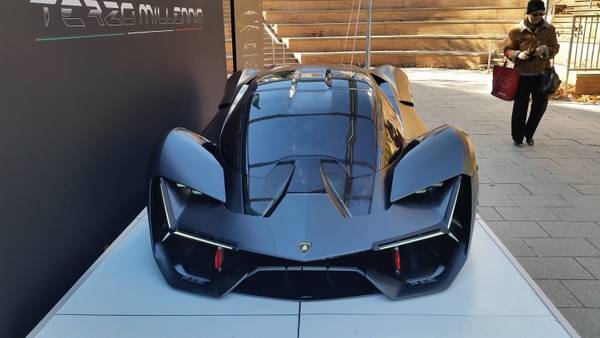
MIT researchers collaborate with Lamborghini to develop an electric car of the future
"Research from the Dinca and Hart labs, paired with Lamborghini’s “hypercar” concept, will result in the Terzo Millenio, an electric sports car for the third millennium. Members of the MIT community who passed through the Stata Center courtyard last week likely found it hard not to notice the Lamborghini parked there as if it were visiting from the future. The car’s name — Terzo Millenio — says it all. Terzo Millenio is an automobile prototype for the third millennium, and its unique ability to deliver high peak power and regenerate kinetic energy, all while ensuring the ability to release and harvest electric power, can be attributed to the work of MIT associate professor of chemistry Mircea Dinca. The Terzo Millenio aims to be self-healing and electric — concepts that today seem about as far-fetched as the hovercrafts in "Back to the Future II"’s imagining of 2015. However, in reality, this technology is as attainable as it is visionary." [...]

The Microscopic Origin of Efficiency Droop in LEDs
"Semiconductor study shows that the coupling between electrons and thermal vibrations may be sapping energy from LEDs Light-emitting diodes—or LEDs, as they are commonly known—have been slowly replacing incandescent light bulbs in applications ranging from car taillights to indicators on electronics since their invention in the 1960s. Eschewing the filament of an incandescent bulb and the mercury vapor of a fluorescent bulb, LEDs instead generate light by applying a voltage across a semiconductor. Electrons combine with holes (places in the crystalline structure where an electron could but does not exist, making them positively charged), leading to the emission of photons—particles of light. Most LEDs use semiconductors made from a material called gallium nitride (GaN). These GaN LEDs are reliable and safe, but have the disadvantage of quickly becoming inefficient as the voltage is scaled up, a phenomenon called "efficiency droop." "More than 10 percent of electricity generated in the U.S. is used for lighting in the commercial and residential sectors." [...]
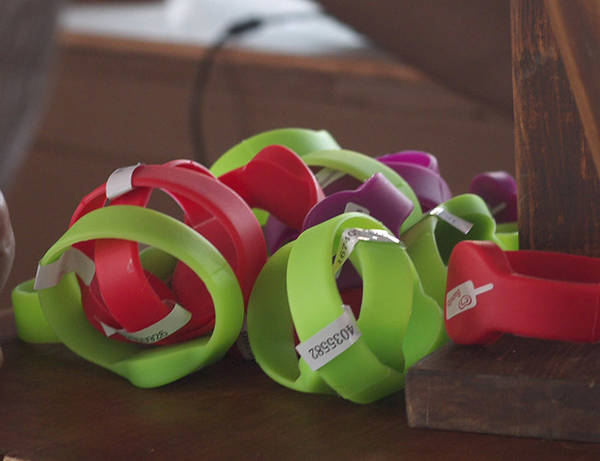
3D printer makes first wearable 'battery'
"Imagine printing off a wristband that charges your smartphone or electric car with cheap supplies from a local hardware store. That’s the direction materials research is heading at Brunel University London where scientists have become the first to simply and affordably 3D print a flexible, wearable ‘battery’. The technique opens the way for novel designs for super-efficient, wearable power for phones, electric cars, medical implants like pacemakers and more. The printer squirts stacks of silicone, glue and gel electrolyte pastes like a layer cake, to make what looks like a clear festival wristband. Sandwiched inside is a supercapacitor, which stores energy like a battery, but on its surface and without chemical reactions. “This is the first time a flexible supercapacitor including all its components has been produced by 3D printing,” said Milad Areir at Brunel’s Cleaner Electronics Research Group." [...]
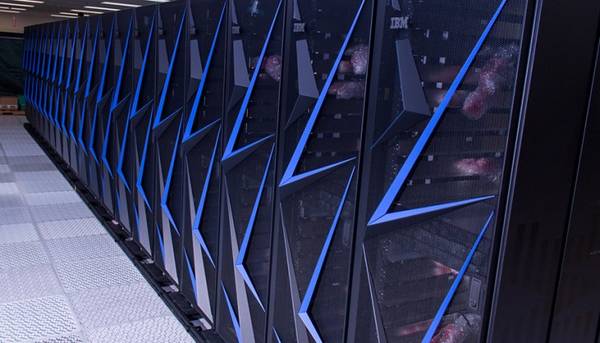
Siting Sierra: Lawrence Livermore’s newest and fastest supercomputer is taking shape
"Work is moving fast and furious in the Livermore Computing Complex at Lawrence Livermore National Laboratory (LLNL), where siting and installation for Sierra, the Lab’s next advanced technology high-performance supercomputer, is kicking into high gear. Trucks began delivering racks and hardware over the summer for what will eventually be a 125-petaFLOPs/second (peak) machine, projected to provide four to six times the sustained performance of the Lab’s current workhorse system, Sequoia. Sierra is scheduled for acceptance in fiscal year 2018, and has involved the labor of hundreds of Laboratory and vendor employees. “It’s a major effort,” said Bronis de Supinski, Livermore Computing’s chief technology officer and head of Livermore Lab’s Advanced Technology (AT) systems. “It involves people on my team, making sure ahead of time, that we’ve really specified what we need correctly, and working closely with IBM to make sure they understand what our requirements are across the full range of aspects of the system: system software and tools, compilers, support for performance analysis and debugging tools. Most importantly, they’re working directly with the application teams to make sure they’re ready.” It’s taken years of preparation to get to this point." [...]
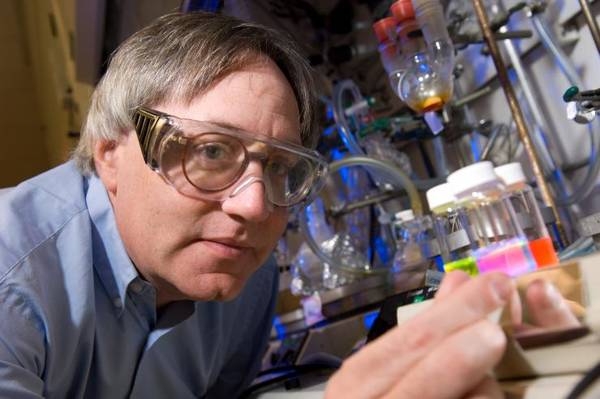
Advancing the Path to Organic Electronics Beyond Cell Phone Screens
"A discovery by an international team of researchers from Princeton University, the Georgia Institute of Technology and Humboldt University in Berlin points the way to more widespread use of an advanced technology generally known as organic electronics. The research, published November 13, 2017, in the journal Nature Materials, focused on organic semiconductors, a class of materials prized for their applications in emerging technologies such as flexible electronics, solar energy conversion, and high-quality color displays for smartphones and televisions. In the short term, the advancement could particularly help with organic light-emitting diodes that operate at high energy to emit colors such as green and blue. “Organic semiconductors are ideal materials for the fabrication of mechanically flexible devices with energy-saving, low-temperature processes,” said Xin Lin, a doctoral student and a member of the Princeton research team. “One of their major disadvantages has been their relatively poor electrical conductivity. In some applications, this can lead to difficulties and inefficient devices." [...]

Quantum Internet goes Hybrid
"ICFO researchers report the first demonstration of an elementary link of a hybrid quantum information network, using a cold atomic cloud and a doped crystal as quantum nodes and single photons as information carriers. In a recent study, published in Nature, ICFO researchers Nicolas Maring, Pau Farrera, Dr. Kutlu Kutluer, Dr. Margherita Mazzera, and Dr. Georg Heinze led by ICREA Prof. Hugues de Riedmatten, have achieved an elementary “hybrid” quantum network link and demonstrated for the first time photonic quantum communication between two very distinct quantum nodes placed in different laboratories, using a single photon as information carrier. The key elements of a Quantum Information Network are quantum nodes, that store and process the information, made up of matter systems like cold atomic gases or doped solids, among others, and communicating particles, mainly photons. While photons seem to be perfect information carriers, there is still uncertainty as to which matter system could be used as network node, as each system provides different functionalities. Therefore, the implementation of a hybrid network has been proposed, searching to combine the best capabilities of different material systems. Past studies have documented reliable transfers of quantum information between identical nodes, but this is the first time this has ever been achieved with a “hybrid” network of nodes." [...]

A faster way to make Bose-Einstein condensates
"Method of laser cooling may speed up investigations into magnetism and superconductivity. The world of an atom is one of random chaos and heat. At room temperatures, a cloud of atoms is a frenzied mess, with atoms zipping past each other and colliding, constantly changing their direction and speed. Such random motions can be slowed, and even stopped entirely, by drastically cooling the atoms. At a hair above absolute zero, previously frenetic atoms morph into an almost zombie-like state, moving as one wave-like formation, in a quantum form of matter known as a Bose-Einstein condensate. Since the first Bose-Einstein condensates were successfully produced in 1995 by researchers in Colorado and by Wolfgang Ketterle and colleagues at MIT, scientists have been observing their strange quantum properties in order to gain insight into a number of phenomena, including magnetism and superconductivity." [...]
Modelos 3D
Com a disponibilidade de ferramentas que permitem dar azo a nossa imaginação na criação de peças 3D e espaços como o thingiverse para as publicar, esta rubrica apresenta alguns modelos selecionados que poderão ser úteis.
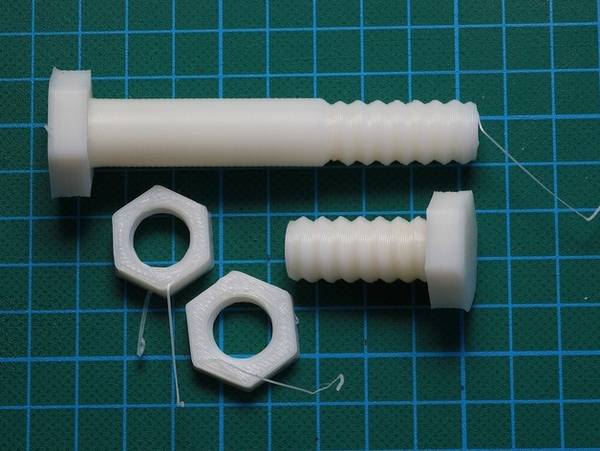
Poor man's openscad screw library
"Update: Due to some bugs in the initial version, a revision of the OpenSCAD library has been uploaded, please use "polyScrewThread_r1.scad". Thanks a lot to mechadense for reporting the bugs! This is my humble take on a screw library to be used in your OpenSCAD scripts. If you are serious, please be, you'll better use http://www.thingiverse.com/thing:8793 syvwlch. Anyway, I had this thing for months in the lost projects folder suffering from some serious issues, well some of them remain (it doesn't render) and once the dust has been shaken it compiles quite nice and printable things. Instead of functions, this thing uses loops." [...]
Documentação
A documentação é parte essencial do processo de aprendizagem e a Internet além de artigos interessantes de explorar também tem alguma documentação em formato PDF interessante de ler. Todos os links aqui apresentados são para conteúdo disponibilizado livremente pelo editor do livro.

newelectronics de 14 Novembro 2017
"New Electronics is a fortnightly magazine focusing on technological innovation, news and the latest developments in the electronics sector. Downloadable as a digital page turner or pdf file, or offered as a hard copy, the New Electronics magazine is available in a format to suit you. " [...]

HackSpace magazine #1
"Fancy smoking bacon with your very own cold smoker? How about protecting your home with a mini trebuchet for your front lawn? Or maybe you’d like to learn from awesome creator Becky Stern how to get paid for making the things you love? No matter whether it’s handheld consoles, robot prosthetics, Christmas projects, or, er, duct tape — whatever your maker passion, issue 1 is guaranteed to tick your boxes! HackSpace magazine is packed with content from every corner of the maker world: from welding to digital making, and from woodwork to wearables. And whatever you enjoy making, we want to see it!" [...]
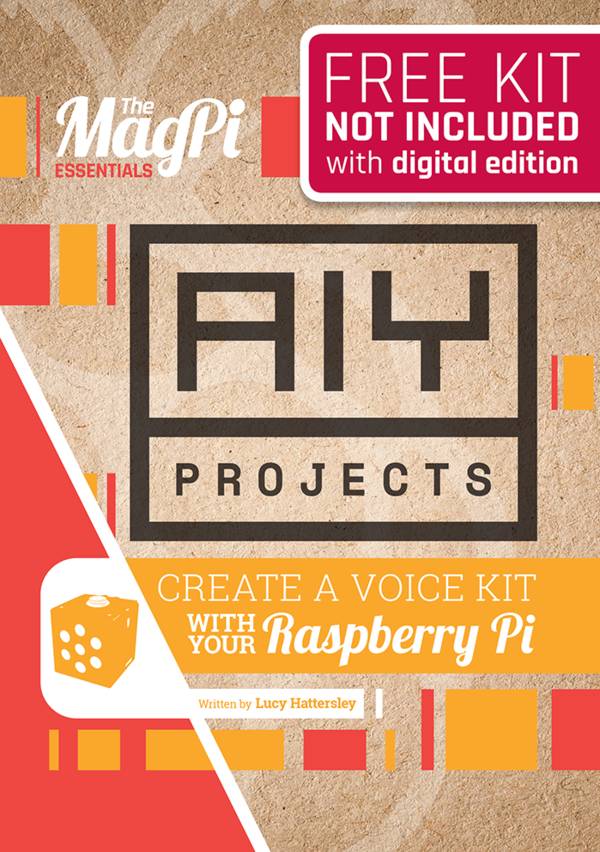
AIY Voice Essentials
"Google AIY Projects brings do-it-yourself artificial intelligence (AI) to the maker community. You will build a cardboard device (kit sold separately) that uses the Google Assistant to answer questions, like “how far away is the moon?” or “what is 18 percent of 92?”. Inside the guide you will find chapters on the following: Made by you with Google: the team behind the AIY Projects kit Your AIY Projects Voice Kit Assemble the kit Set up the the voice assistant software Build a voice recognizer Create a voice recognizer Control an LED Attach a servo Control a DC motor" [...]
Projetos Maker
Diversos Projetos interessantes.
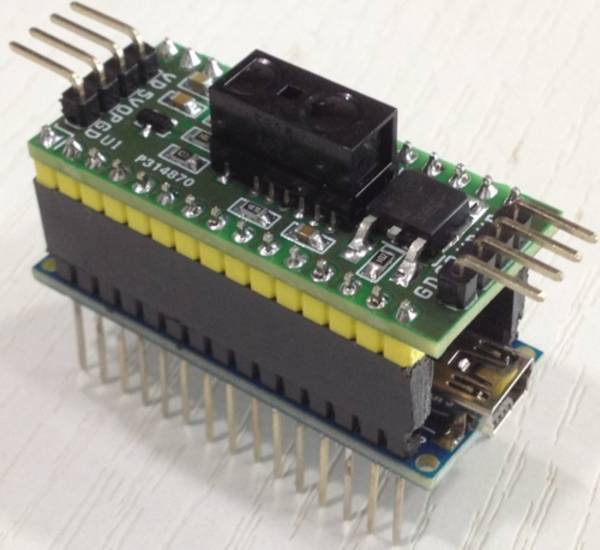
Distance Measuring Sensor Shield for Arduino Nano Using GP2Y0D810Z0F
"The project published here is a distance measuring sensor shield for Arduino Nano including power driver BJT transistor to drive a load like solenoid, motor or LED. This project can be used as Arduino shield or as stand-alone sensor. GP2Y0D810Z0F from Sharp is heart of the project, The sensor is a composed of an integrated combination of PD (photo diode) , IRED (infrared emitting diode) and signal processing circuit. The variety of the reflectivity of the object, the environmental temperature and the operating duration are not influenced easily to the distance detection because of adopting the triangulation method. The output voltage of this sensor stays high in case an object exists in the specified distance range. So this sensor can also be used as proximity sensor." [...]
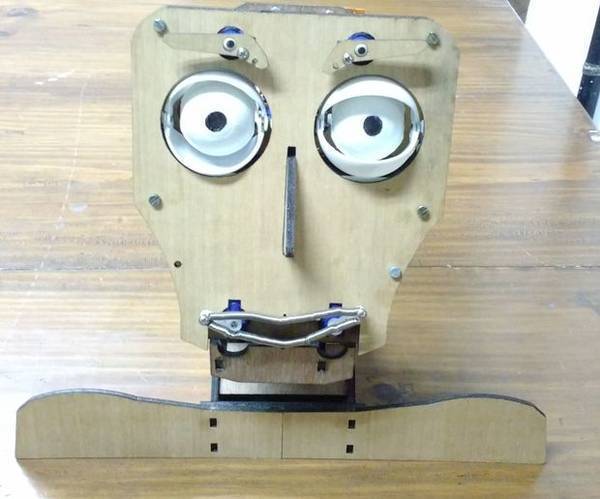
Fritz - Animatronic Robotic Head
"Hey guy's welcome to my instructables let's make. Fritz -The Animatronic Robotic Head. Fritz is open source and awesomely amazing. It can be used for anything. Ex: learning human emotions, receptionist, Halloween stud, flirter, singer and much more all relies on your imagination! It can also sing songs and the best of all it has a changeable base plate so you can etch anyones face on it and attach to Fritz and Fritz becomes your man." [...]
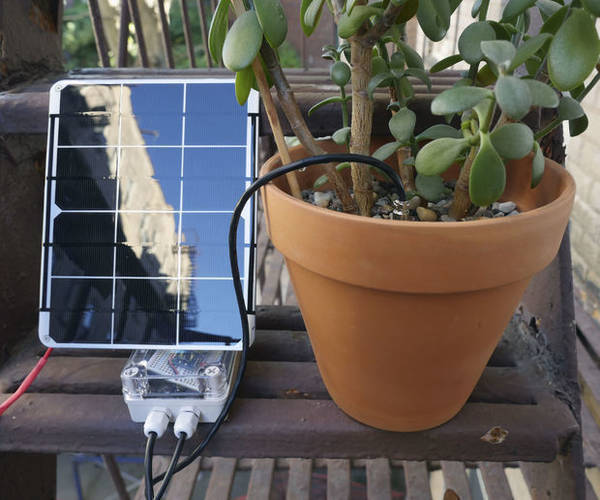
Solar Soil Moisture Meter With ESP8266
"In this Instructable, we're making a solar powered soil moisture monitor. It uses an ESP8266 wifi microcontroller running low power code, and everythings waterproof so it can be left outside. You can follow this recipe exactly, or take from it the useful techniques for your own projects. If you're new to microcontroller programming, please check out my Arduino Class and Internet of Things Class to get caught up on the basics of wiring, coding, and connecting to the internet. This project is part of my free Solar Class, where you can learn more ways to harness the sun's energy through engraving and solar panels. " [...]
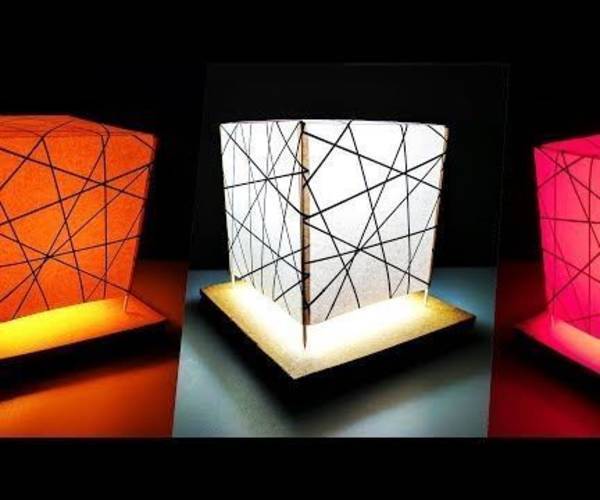
DIY Night Lamp Light Stand for Room Decor
"DIY at HOME - How to make Paper Night Lamp Light Stand for Room Decor which is simple and Easy to make DIY Project for kids to enjoy and have fun making by yourself #night #lamp #stand #paper #DAH I had an idea of pimping up a gaming desk or a small desk beside a bed or in the hallway .. and I came up with this hope you all like it and have fun making it and trying out yourself :) .. Let me your thoughts on this video by commenting down on the comment section. Just follow the step by step instructions in the video and have fun by trying out by yourself !!! " [...]
Sunflower - Arduino Solar Tracker
"'The Sunflower' is an Arduino based solar tracker which will increase the efficiency of the solar panel while charging.In modern solar tracking systems, the solar panels are fixed on a structure that moves according to the position of the sun. Let us design a solar tracker using two servo motors, a light sensor consisting of four mini photocells and Arduino UNO board. " [...]
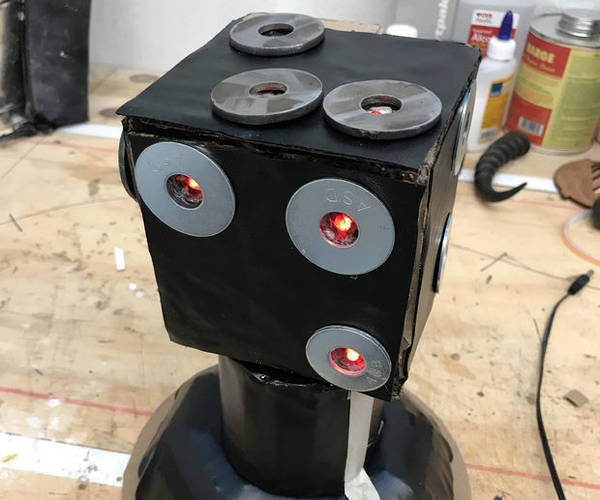
Leather Cube Lamp
"Dear Instructables Community, My name is Andrew Sapala and I would like to share with you how I built my leather cube lamp. I was inspired by Lemarchand's Box from the Hellraiser films by Clive Barker. The project was for a lamp proposal for my Computational Craft's Midterm taught by Liza Stark at Parsons in NYC. Before we begin I would like to give you a material breakdown for the project. Materials: Cardboard Scrap metal rods 15-18 LED lights Black Leather Alligator clips Four AA batteries in power case as Arduino power source 3 volt battery Box-cutting knife 1/4 inch copper tape Conductive fabric Lead-free solder Solder gun Arduino UNO board Breadboard (preferably small) Colored pin wires (12) Hot Glue + Glue gun Thin metal cloth pinsI will walk you through how I created the cube in bite-sized chunks. If you have any questions about the project please leave me a comment and I will respond promptly." [...]
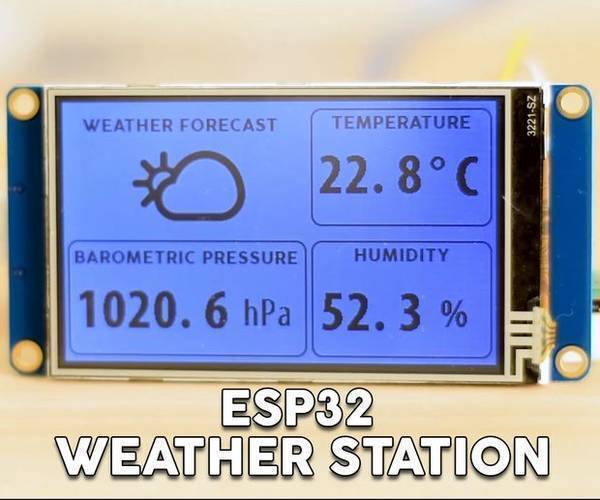
ESP32 WiFi Weather Station With a BME280 Sensor
"Dear friends welcome to another tutorial! In this tutorial we are going to build aWiFi enabled weather station project! We are going to use the new, impressive ESP32 chip for the first time along with a Nextion display. In this video, we are going to make this. It is yet another weather station project I know, but this time we use the new ESP32 chip! We also use the new BME280 sensor which measures the temperature, the humidity, and the barometric pressure." [...]

How To Connect Arduino Industrial 101 to Cayenne
"How to connect Arduino Industrial 101 to Cayenne over MQTT, and send data from BMP180 and TSL2561. " [...]
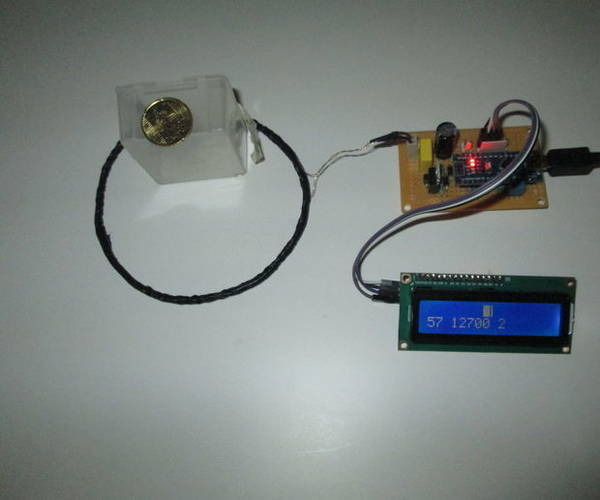
Arduino Based Pulse Induction Detector - LC-Trap
"While looking for further ideas for a simple Ardino Pulse Induction metal detector with only one supply voltage I came across the homepage of Teemo: http://www.digiwood.ee/8-electronic-projects/2-metal-detector-circuit He created a simple Pulse Induction detector using the LC-Trap principle. Similar circuits were posted here on Instructable by TechKiwiGadgets. Exept that the Teemo circuit uses the internal comparators of the a PIC microcontroller, thus needing less external components So I was challenged to use the Arduino instead of a PIC-Controller for this schematic and look how far I can get. " [...]

Optical Isolated Single Wire Communication
"Hello, for an aquarium project I needed a long electrical wire that could: supply power to device allow communicationOther Current and voltages are low Wire is +/- 3m long Slow data transfers Bidirectional communication, half duplex Limited space in device Galvanic isolationThe communication is between 2 devices. The device can be an Arduino, Raspberry PI or other device using the digital pins. " [...]
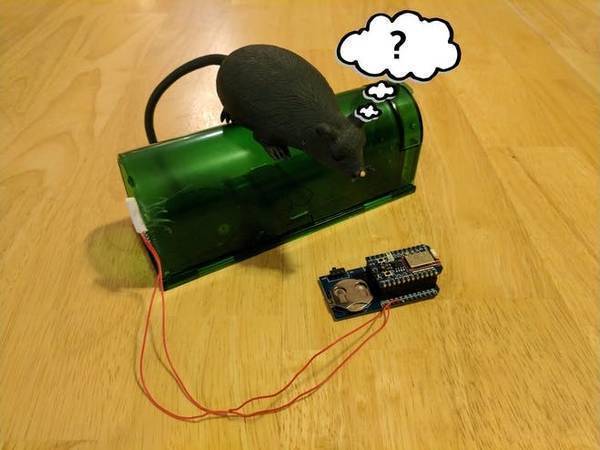
IoTrap: The Better Mousetrap
"Tired of crawling into attics/basements to catch critters? Here's a trap that can text you when it needs attention. Inspiration I live in the woods in New England, and every fall the critters that enjoyed the warm summers outside decide they need a new warm place for the winter, and that generally means my attic. They just seem to love sneaking in and making nests in the insulation, and I want them out of my house. It's a yearly battle. Trapping them this time of year is pretty much a necessity, but there are two problems." [...]
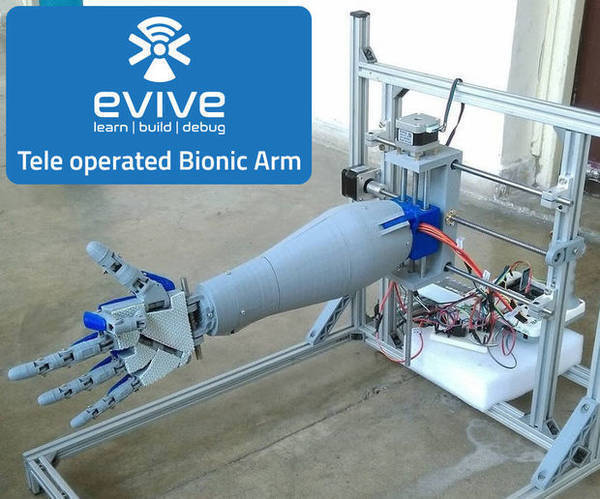
Tele Operated Bionic Arm
"In this Instructable, we will make a tele operated bionic arm, which is a robotic arm similar to human hand with six degrees of freedom (five for figures and one for wrist). It is controlled with human hand using a glove which have flex sensors attached for finger feedback and IMU for wrist angle feedback. These are the key features of the hand: A robotic hand with 6 degrees of freedom: Five for each finger controlled by strings attached to servo and wrist movement again done using a servo.As all the degrees of freedom are controlled using a servo, we don't need extra sensors for feedback. Flex sensors: Five flex sensors are attached to a glove. These flex sensors gives the feedback to micro-controlled which is used to controlled the bionic arm. IMU: IMU is used for getting wrist angle of the hand." [...]
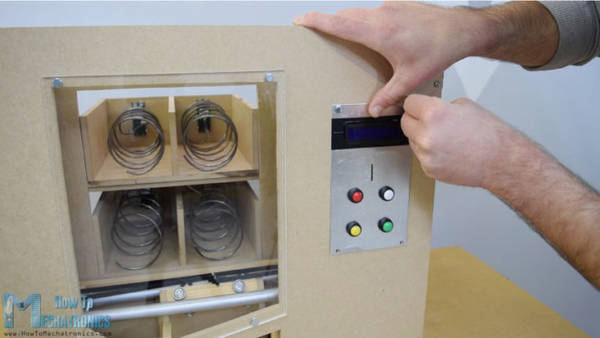
DIY Vending Machine – Arduino based Mechatronics Project
"In this project we will learn how to make an Arduino based DIY vending machine. I will show you the entire process of build it, starting from cutting and assembling the MDF boards, to connecting all electronic parts together and writing the Arduino code. The vending machine features four discharging units controlled via four continuous rotation servo motors, a carrier system controlled via stepper motors, an LCD, four buttons for selecting an item and a coin detector. You might be thinking now that the item carrier is not so useful for this vending machine, and yes, you are probably right. But my idea here was to make this project more interesting or a bit more complex so you can learn more new stuff. I think this project idea can be great for electronics or mechatronics students considering building one as their final year project, as well as for any Arduino enthusiasts." [...]
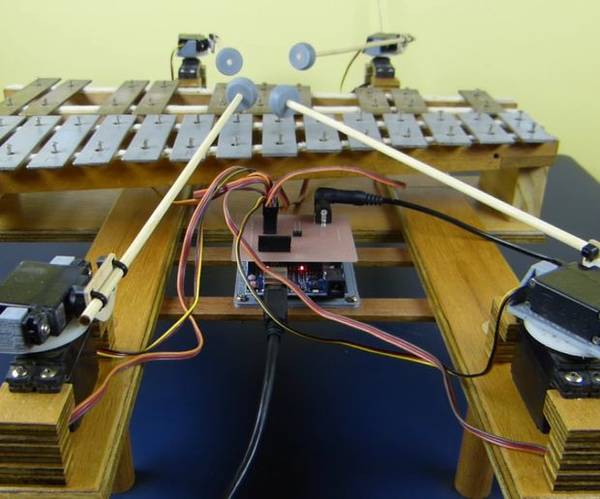
Making the Spielatron (Robotic Glockenspiel)
"We created this robotic glockenspiel from parts that we already had and made. It is still experimental and is in version one. The Spielatron is controlled by an Arduino which plays Midi commands sent to it from a PC. Present limitations are It is monophonic ie can only play one hammer at a time.The servo speed limits either the beats per minute or the note length of the music eg you cannot play a semi quaver at 120 BPM. " [...]

Make Your Own Solid State Relay
"In this project we will have a look at solid state relays, find out how they work and when to use them and in the end create our own DIY Solid State Relay. Let's get started! " [...]
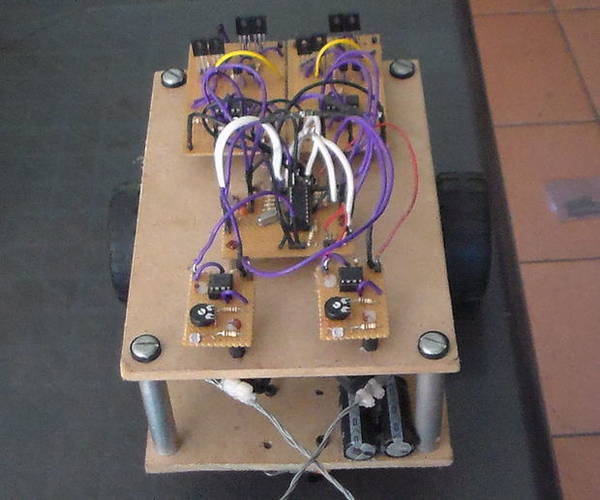
PIC Based LF and Avoiding Robot
"Introduction In this instructable you will learn to make a light following and avoiding robot. My inspiration comes from robots imitating common human behavior, for example you will not just walk into a wall for no reason. Your brain communicates with your muscles/ organs and immediately will stop you. Your brain works very similarly to a basic micro-controller receiving inputs and processing them into outputs, in this case your brain relies on your eyes for information. At the same time it's acceptable to walk into a wall when one is blind. Your brain receives no inputs from your eyes and cannot see the wall." [...]

How to Emulate a TV Remote or Else With Arduino Irlib
"IntroductionHi everyone and welcome to my first Instructable. Today we will learn, as the title says, to emulate e TV remote or something similar that works with Infrared signals using Arduino (any model). The problem was: How can I trasmit codes to an object if I don't know the code? Searching on the internet I didn't find the answer to my question so I started thinking and invented this method by myself. In this tutorial I'll show you how to do that. P.S." [...]
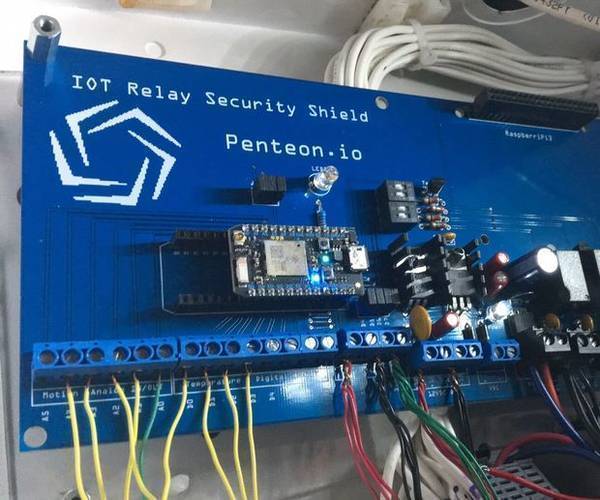
Complete Raspberry Pi / Nova Wireless Home Monitoring and Automation System ...
"The Raspberry Pi is an awesome little device ..I will show how you can have a complete stand alone wireless Security / Home Automation System on One device ..We will be installing OpenHab http://openhab.orgNode Red modules http: node Red.orgParticlePi program http://particle.ioTying them all together seamlessly and adding Particles as wireless sensor inputs and controlsWe will make our own PCBs and solder them up We will make Wireless Sensor shieldsWireless Relay shields Screw shields (For the ParticlePi) We will wire them up program them and showcase the final product" [...]
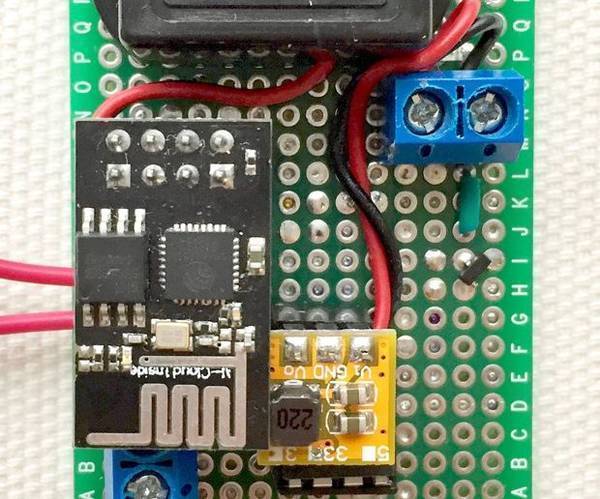
IoT Water Alarm
"I have recently experienced kitchen drain backup. Had I not been at home at the time, it would have caused floor and drywall damage in my apartment. Fortunately, I was aware of the problem and ready to scoop the water out with a bucket. This got me thinking about purchasing a flood alarm. I discovered plenty of affordable products on Amazon, but the ones with internet connectivity had a significant percentage of negative reviews, primarily because of issues with proprietary notification services. That's why I decided to make my own IoT water alarm that would use trustworthy notification means of my choice." [...]
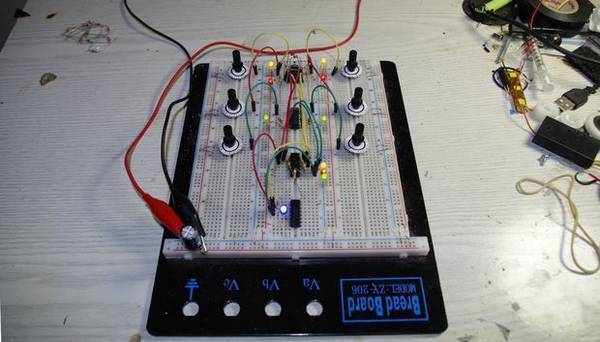
The PotLock
"this is a 3 digit combination lock with potentiometers, logic gates and differential comparators" [...]
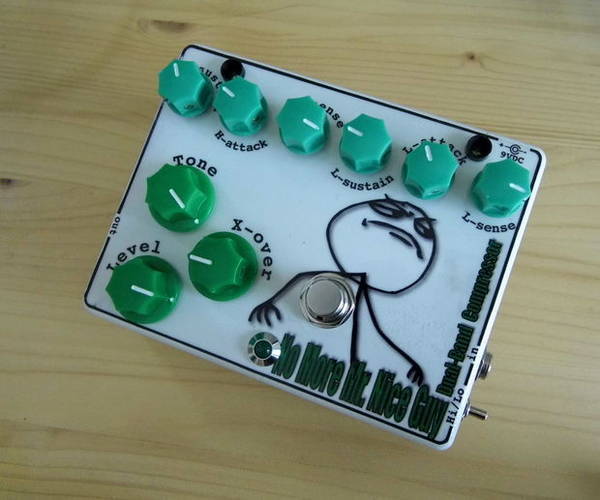
Dual-Band Guitar/Bass Compressor
"Background story: My bass playing friend was getting married and I wanted to build him something original. I knew he has a bunch of guitar/bass effect pedals, but I never saw him use a compressor, so I asked. He's a bit of a feature-addict so he told me the only compressors worth using are multi-band, lots of knobs to play around with. I had no idea what a multi band compressor was, so I googled around and found some example schematics (like here and here). Knowing that my friend would not be happy with a meager 5 button pedal, I decided to design my own dual-band (well, not 'multi' but ok...) compressor. Bonus challenge: No integrated circuits allowed - only discrete components and transistors." [...]
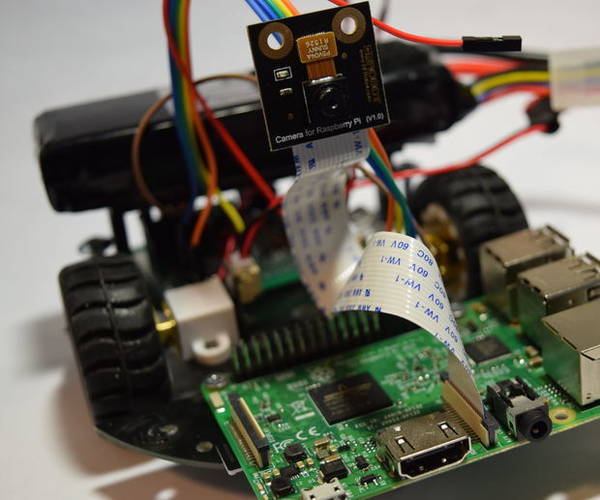
Raspberry SPy Robot
"This project allows you to drive a robot via a webpage and view a livestream. It can be used to spy on pets, make sure nothing is burning in your oven, and even bird watch! DFRobot provided the Raspberry Pi 3 and the Raspberry Pi camera module. " [...]

Arduino 8 Step Sequencer Keyboard
"Since the start of building modular synths, ive always been looking for an arduino powered sequencer. but never really happy with the projects that were about. because it was still menu dives and button combinations. which is not what you wanna be messing about with! you may aswell use a computer and a mouse ha. I wrote this a few years back, and it does exist in a few other variations like a clock skip sequencer, aswell as one that is sort of like the intellijel metropolis." [...]

DUO BOT : the First of Its Kind**
"INTRODUCTION : Hi guys !! This is my very FIRSTINSTRUCTABLE . Truly speaking , I decided to compile this project as I wanted to take part in the Instructable contest . At first I was confused on what would be best for my project as I wanted something new.............something special . Even after putting much effort, I could not get upto something. I strolled the web a several times but found nothing new." [...]

Arduino Nano to PIC40/28 Pin Shield
"Arduino Nano to PIC40/28 PIN development shield is an extension for Arduino Nano. This project is useful to create many projects using PIC40/28PIN shield published on electronics-lab.com, refer to schematic and connection diagram to use this shield. Two on board regulators are provided which outputs 5V DC and 3.3V DC, this dual supply helps many projects which need dual supply. Jumper J1 is for supply selection VCC To 3.3V or 5V, diode provided at input of regulator for reverse supply protection. Not populated J4, Close J3 to supply 5V to Nano. " [...]

Water Tank Levels by WiFi on Your Phone
"This instructable is entered in the "Wireless" contest. Please vote for me, Thank you When I moved to a rural property in Australia I was faced with the fact my water supply was at the mercy of the Gods; rain from the sky to fill the tanks. I had a capacity of around 30,000 litres across 2 concrete tanks and checking the levels meant climbing up a ladder, lifting a very heavy concrete cover and peering down into the damp darkness to estimate the levels. Not much fun, inaccurate and time consuming, there must be an easier way. Using Blynk and my WLAN was the answer, I could see at a glance the levels on my phone. " [...]
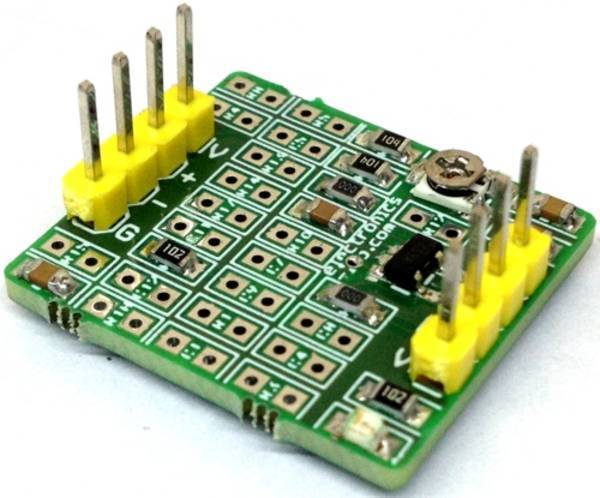
Universal OpAmp Evaluation Board Using LMV321
"The Universal Op-Amp Development board is a general purpose blank circuit board that simplify prototyping circuits for a variety of Op-Amp circuits. The evaluation module board design allows many different circuits to be constructed easily and quickly. This board supports single SOT23-5 package. Universal single Operational Amplifier (Op-Amp) board is designed to aid in the evaluation and testing of the low voltage/low power and some precision operational amplifiers. This board will accommodate single op amp that are assembled in SOT23-5 package. It is designed to use single amplifiers." [...]

How to Make an Ultrasonic Range Finder Using an LCD and Arduino
"In this Arduino tutorial I will show you how to use the HC-SR04 ultrasonic sensor and integrate it with an LCD display, so that it can display the distance between the sensor and certain objects. Materials Needed: - Arduino UNO - Breadboard - 16 x 2 LCD Display - HC-SR04 Ultrasonic Sensor - 10K Potentiometer (Comes with LCD display linked above) - Jumper Cables" [...]
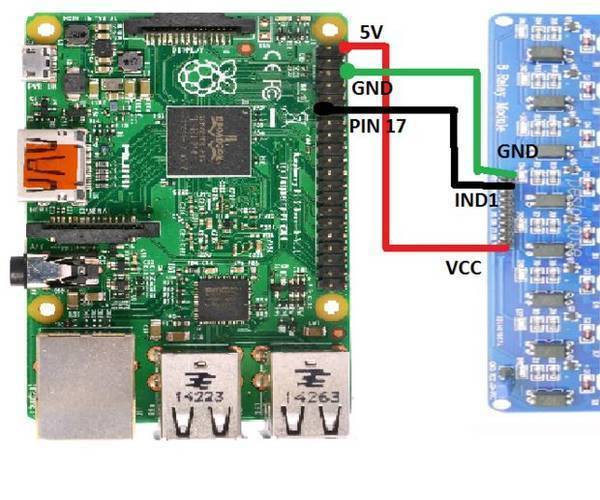
Control Home Appliance With Raspberry Pi Using Django
"Introduction:In this project we are going to switch on the home appliance from remote location using web services. In this we are going to use one raspberry pi interfacing with 4 bulb using relay module with low level trigger. Each bulb is connect in each corner like right, left, top, button. We can trigger the relay from anywhere in the world using a website. In each trigger of relay the correspondence Bulb will glow and one stop button is there for stop operation. " [...]
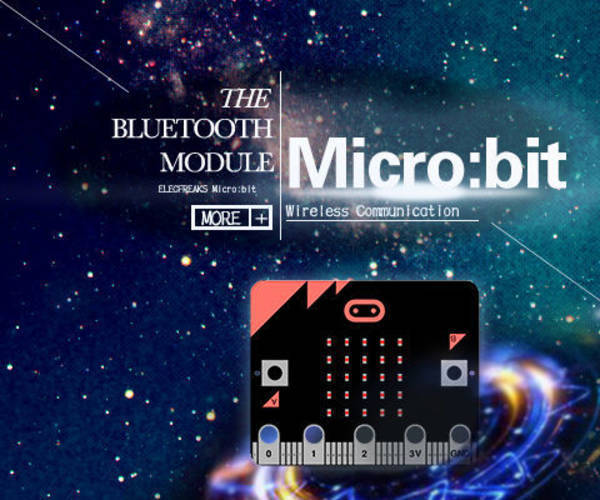
Use HC-06 Bluetooth Module to Realize Micro:bit Communication With Mobile Phone
"Lots of friends around me who play micro:bit tell me that the Bluetooth connection of micro:bit is not stable. It is easy to disconnect. If we use micropython, the Bluetooth cannot even be put to use. Before this problem is solved by micro:bit official, here we have another compromized method. That is to use HC-05/HC-06 module. Today I am going to share with you how to use micro:bit to drive HC-06 module." [...]

PID Controller, Auto-tuning Library And Example For DC Motor
"This provides libraries and examples code of controlling position and speed of DC motor using PID controller and auto-tuning. Introduction Have you ever heard about PID controller? It is a controller that is widely used in industrial to control various process variables such as temperature, pressure, force, feed rate, flow rate, chemical composition (component concentrations), weight, position, speed, and practically every other variable for which a measurement exists. In this article, I focus on using PID to control position and speed of Brushed DC motor. What decides performance of a PID controller? Performance of PID is decided by Kp, Ki and Kd gain (coefficients for the proportional, integral, and derivative terms)." [...]
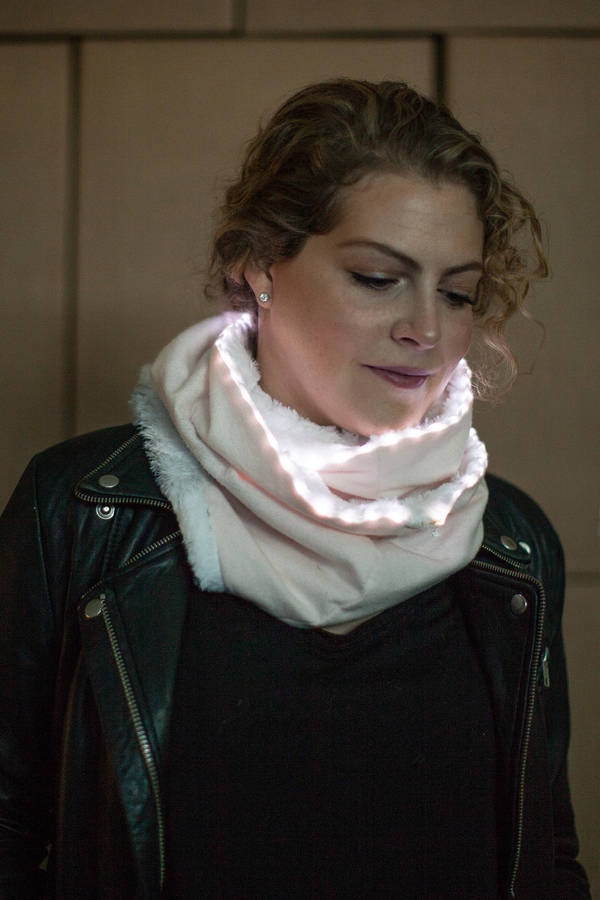
LilyPad Safety Scarf
"In this project, we’ll create a wearable safety scarf The safety scarf is embedded with LilyPad Hardware and a ribbon of LEDs. It is designed for pedestrians to increase visibility when walking the streets at night. The LED ribbon is triggered when light is low, making the wearer more visible to vehicles, bikers, and other pedestrians. " [...]
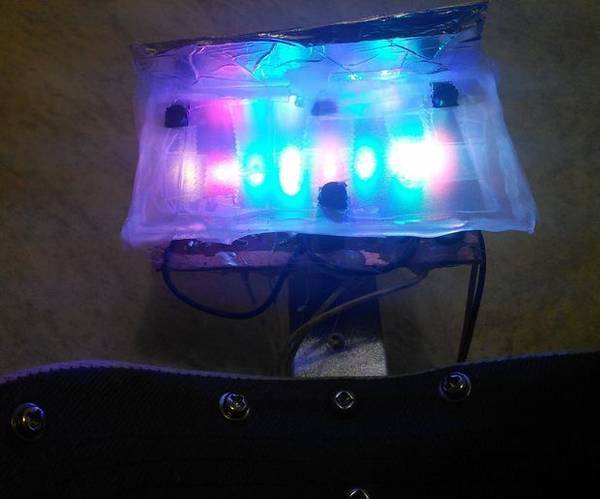
Visor Mounted Multi-Colour LED Light Therapy Lamp
"With a light therapy lamp on your hat, you can use it while doing activities that requires moving around such as exercising and working. This lamp has red, yellow, cyan, and blue LEDs with brightness control. It turns off after 15 or 45 minutes. It's powered by a rechargeable 8.4V battery. In addition to blue LEDs, other colour were used because they have different benefits. Cyan LEDs may be an alternative to blue LEDs." [...]
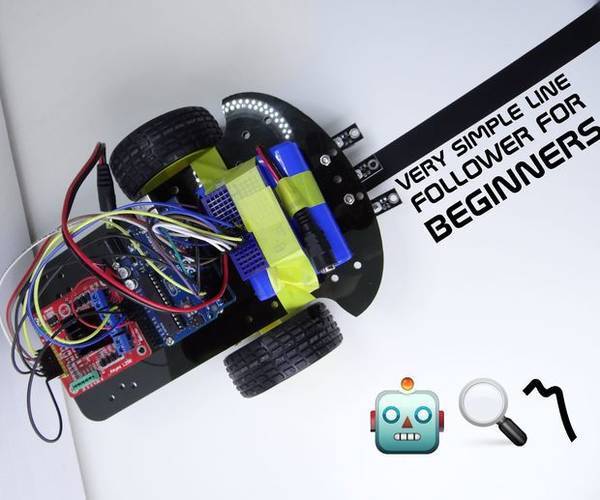
Very Simple Line Follower for Beginners
"A lot of people want to start building robots but dont know how to start and what to build first. Some time ago I have made a very simple robot for beginners that avoids obstacles, a lot of people like this project so much that I have decided to make a second version of this project. This time we will make a line follower robot, thats very popular type of robot that is a little bit more sophisticated than object avoiding one. You can even see line followers on robotic competitions, check it out on YouTube, they are so fast! Our robot wouldnt be so fast it will be like a introduction to robotics, just to let you make your first robot and get some knowledge to build better ones in the future. I promise to keep things as simple as possible to let everyone make it and understand it." [...]
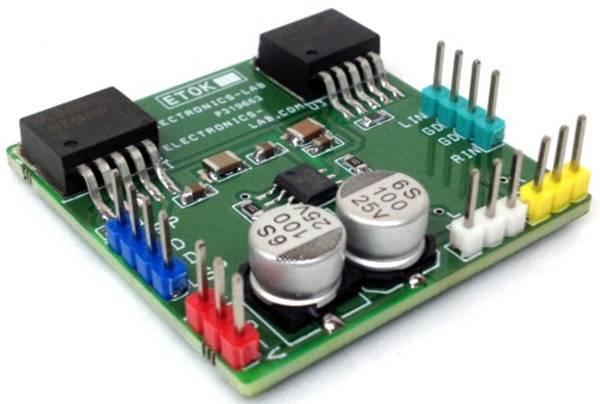
Hi-Fi Stereo Headphone Amplifier using LME49600
"This project is the ideal solution for high output, high performance high fidelity stereo head phone amplifier. The project consists of Op-Amp LME498720 and LME49600 as output driver. The LME49600 is able to drive 32Ω headphones to a dissipation of greater than 500mW at 0.00003% THD+N while operating on ±12V power supply voltages. The LME49600 is a high performance, low distortion high fidelity 250mA audio buffer. The LME49600 is designed for a wide range of applications and is fully protected through internal current limit and thermal shutdown. " [...]

Continuity Tester
"This article describes a simple continuity tester, based on an ATtiny85 and a piezo buzzer, designed for checking circuit wiring, or tracing out the tracks on a PCB: It has a low threshold resistance of 50Ω to avoid false positives, and passes less than 0.1mA through the circuit under test, to avoid affecting sensitive components. It's powered from a small button cell, and automatically switches itself off when not in use, avoiding the need for an on/off switch. Introduction I recently designed a PCB with very fine tracks for a project I'm planning for a future article, and thought it would be useful to have a small, portable continuity tester to help check for solder bridges on the SMD soldering. Although most multimeters include a continuity tester mode, I wanted to design a stand-alone tool with the following advantages: Smaller and more convenient than a multimeter. Low threshold resistance of 50Ω, avoiding false positives due to other components in the circuit. Fast response, so you can drag the probe across a line of pins to detect shorts." [...]

Circuit Python IR Remote for Apple TV
"IR remote to use with Apple TV (gen. 3) to clone functionality of original remote. Coded with Circuit Python. The Apple TV remote (Gen. 3) is a prime example of Apple's design point of view. Sleek, minimal and not practical. Although pretty with it's silver finish, it's tiny. It's smaller than my already small hands and as a result it can be easily lost; like mine which was MIA from February until the end of October." [...]

Arduino Word Clock
"Further details on this build on my site here Word Clock Arduino Word Clock with minute resolution of time in words and linear display of seconds. There are also modes for digital clock, analogue clock, temperature & humidity, & also three games, Game of Life, Simon & Tetris. The clock can be stand alone or run as a slave off a Master Clock if required. There is an option for PIR control so the clock automatically turns off when no one is in the room. The Clock measures 500mm x 500mm (19.68" x19.68") weighs 12lb (5.5Kg) and is designed to be wall mounted. There are touch pads in each corner to setup and control the clock." [...]

Make a Maze Runner Robot
"Maze-solving robots originate from the 1970s. Since then, the IEEE has been holding maze solving competitions called the Micro Mouse Contest. The aim of the contest is to design a robot that finds the midpoint of a maze as quickly as possible. The algorithms used to quickly solve the maze typically fall into three categories; random search, maze mapping, and right or left wall following methods. The most functional of these methods is the wall following method. In this method, the robot follows the right or left side wall in the maze." [...]

Home Security With Embedded System
"Hello Readers, This is an Instructables for constructing an Home Security System unlike every other Security system. This system has an improved feature TRAP and PANIC Mode Connecting Victim home's owner, neighbour and Police station over network.In this project I'm demonstrating the whole project over Intranet (Closed area Network) not over Internet its your wish if you want to do the same over Internet.. PANIC MODE: (Existing System) When Intruder is detected by the Ultrasonic Sensor. the lights of the home and the buzzer will be blown up resulting the intruder panic and send a SMS notification to the Victim home's owner and his/her neighbour and a Temporary web will be hosted which holds some information about the trespass like at what time the intruder trespass, Time elapsed after the trespass and a input field where the home owner can enter PIN to deactivate the buzzer and home lights remotely. TRAP MODE:(Proposed System) When the Intruder is detected Buzzer and Lights will not blow up.instead a SMS notification containing IP Address will be sent to police station by clicking to the IP Address a web wage will open where police can get the information like Time of trespass, Elapsed time from trespass and address of the victim home and a static google map direction from police station to victim home.And a SMS notification to neighbor and home owner will also be sent. " [...]

CarpeDiemAlarmClock
"CarpeDiemAlarmClock is an alarm clock that is waking you up "gently" by gradually increasing the intensity of a NeoPixel LED-ring, before the alarm hits. The alarm clock shall also has an option to sound a buzzer at alarm time. User must be able to set clock and alarm time The alarm clock will have at least the following modes: Alarm on/off, sound on/off, light on/off. Time will be displayed with NeoPixel devices Project extras Serial commands / debugging Display light shows / demos instead of clock time Code Code is built with the Arduino core for an STM32F103C8 devboard, using the STM32duino tools. FreeRTOS is used, with several tasks and semaphores. Hardware STM32F103C8 devboard (Bluepill clone) Adafruit NeoPixel 24-LED ring (show hour/minute, wake up, cool light shows) Adafruit NeoPixel 8-LED strip (show seconds in binary format, and status) DS3231 RTC Breakout board HC-05 bluetooth module (for serial communication / app) Joystick module (user input, setting alarm/time etc)" [...]
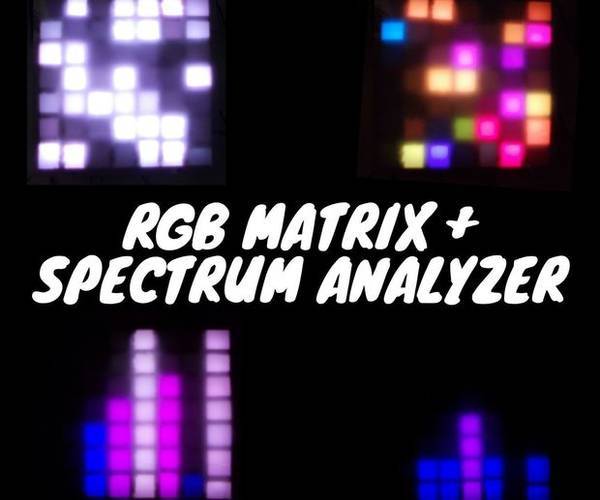
RGB Matrix + Spectrum Analyzer
"Love LEDs?Me too! That's why, in this Instructable, I'll show you how to make an awesome RGB LED Matrix, that can easily turn into a Spectrum Analyzer with the click of a button. After reading, if you think this Instructable has earned it, please vote for it in the LED contest. And without any further ado, let's get started. " [...]

Cat Feeder with ESP8266, Arduino and Telegram
"Arduino based (NodeMCU - ESP8266) Telegram controlled cat feeder I use in order to keep my cats happy and healthy when I'm away. " [...]
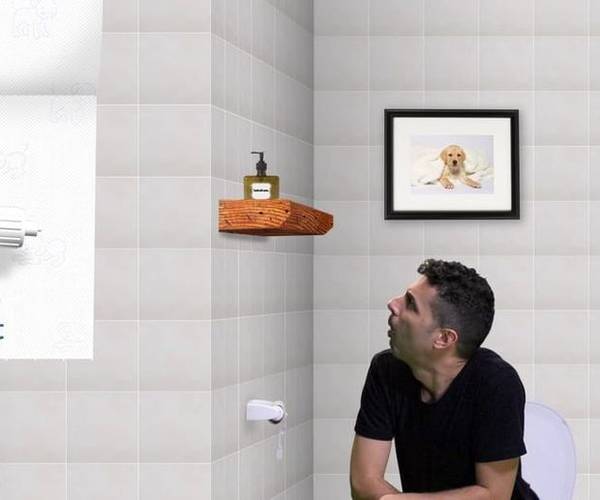
IOToilet
"The IOToilet is the first smart toilet paper holder, that keeps track of our daily usage of toilet paper and allows accumulating stats showing these metrics. And why should I care about my daily usage of toilet paper you may ask? Well, as it turns out, our abdominal health, especially the digestion cycle, has a lot to do with both our physical health and our mental one. For example, here's a nice TED talk (one of quite a few, by the way) that elaborates on this subject: https://www.ted.com/talks/giulia_enders_the_surpri... I was initially commissioned to build 10 units of this device for a branding agency, whose clip you can see above (2nd location), for a purposed marketing campaign for a large company. At the beginning, I dismissed the idea as one coming from an another over-creative mind desperately trying to win a client account, but gradually it grew on me, until I realized the value of the information collected through this device." [...]
Turkey Temperature Tracker
"Do you really want a plastic pop-up timer telling you when your turkey is done? How about a tricked out IoT solution instead? Ever wonder what temperature your Thanksgiving turkey is really at when that plastic pop-up timer pops? When your oven says it's pre-heated to 375°F do you actually believe it? This Thanksgiving I decided to question everything and monitor these temperatures myself. The goal of this project is to monitor, from the interwebs, the ambient temperature inside the oven as well as the meat temperature of my turkey." [...]
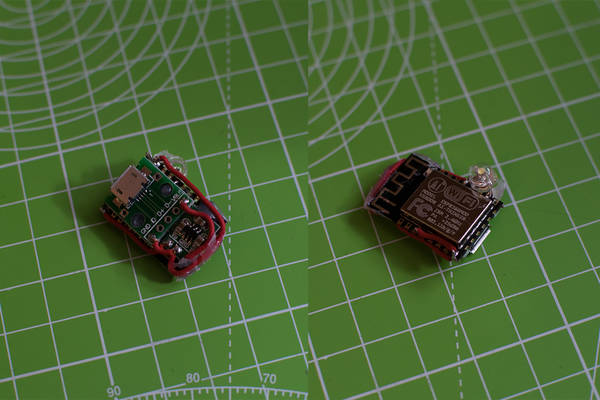
Detect deauthentication frames using an ESP8266
"If the ESP8266 detects deauthentication or disassociation frames it will turn on its LED. That's all ¯\ (ツ)/¯. " [...]
That's all Folks!


